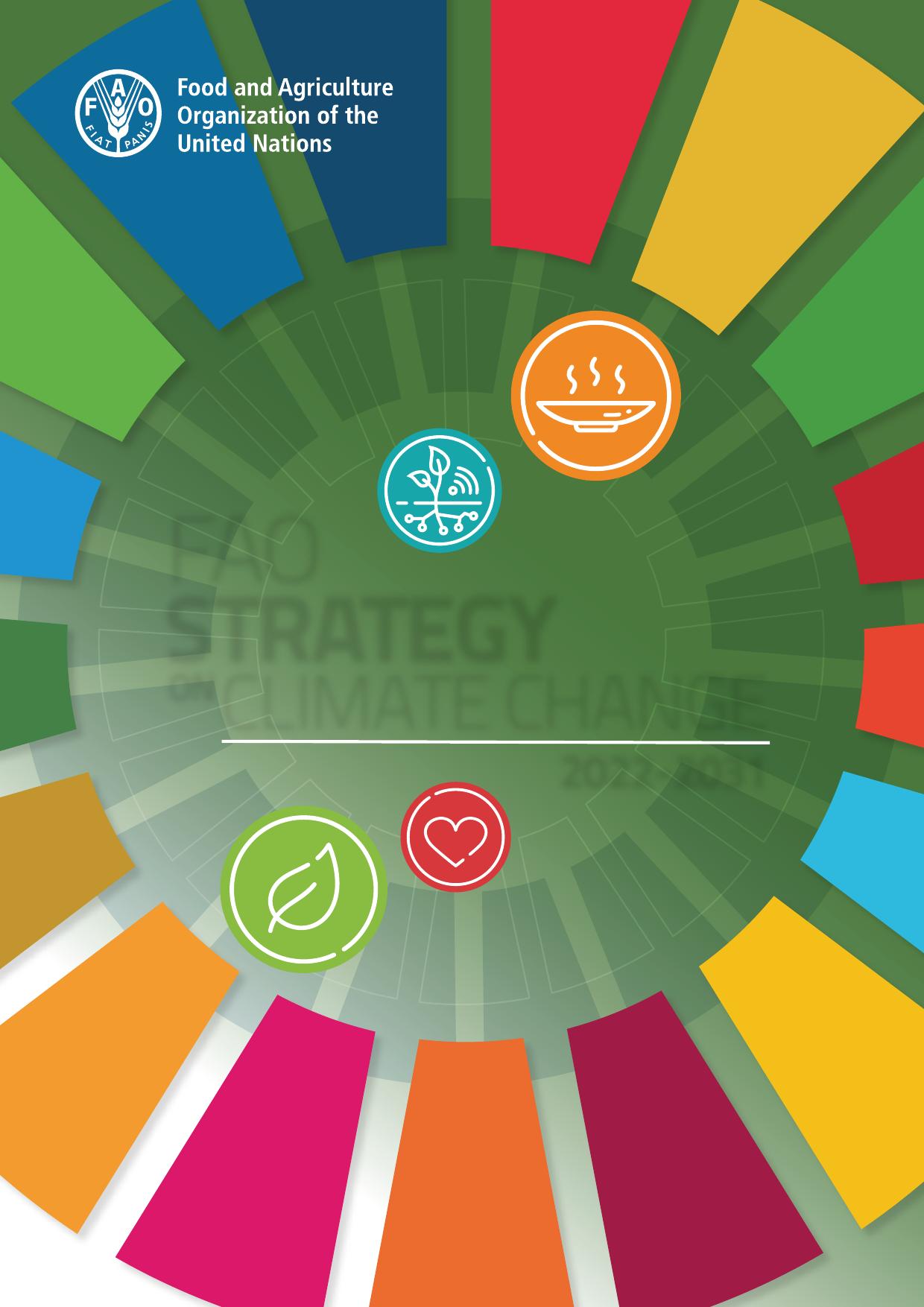FAOSTRATEGYONCLIMATECHANGE2022–2031FoodandAgricultureOrganizationoftheUnitedNationsRome,2022FAOSTRATEGYONCLIMATECHANGE2022–2031FAO.2022.FAOStrategyonClimateChange2022–2031.Rome.ThedesignationsemployedandthepresentationofmaterialinthisinformationproductdonotimplytheexpressionofanyopinionwhatsoeveronthepartoftheFoodandAgricultureOrganizationoftheUnitedNations(FAO)concerningthelegalordevelopmentstatusofanycountry,territory,cityorareaorofitsauthorities,orconcerningthedelimitationofitsfrontiersorboundaries.Thementionofspecificcompaniesorproductsofmanufacturers,whetherornotthesehavebeenpatented,doesnotimplythatthesehavebeenendorsedorrecommendedbyFAOinpreferencetoothersofasimilarnaturethatarenotmentioned.Theviewsexpressedinthisinformationproductarethoseoftheauthor(s)anddonotnecessarilyreflecttheviewsorpoliciesofFAO.©FAO,2022Somerightsreserved.ThisworkismadeavailableundertheCreativeCommonsAttribution-NonCommercial-ShareAlike3.0IGOlicence(CCBY-NC-SA3.0IGO;https://creativecommons.org/licenses/by-nc-sa/3.0/igo/legalcode).Underthetermsofthislicence,thisworkmaybecopied,redistributedandadaptedfornon-commercialpurposes,providedthattheworkisappropriatelycited.Inanyuseofthiswork,thereshouldbenosuggestionthatFAOendorsesanyspecificorganization,productsorservices.TheuseoftheFAOlogoisnotpermitted.Iftheworkisadapted,thenitmustbelicensedunderthesameorequivalentCreativeCommonslicence.Ifatranslationofthisworkiscreated,itmustincludethefollowingdisclaimeralongwiththerequiredcitation:“ThistranslationwasnotcreatedbytheFoodandAgricultureOrganizationoftheUnitedNations(FAO).FAOisnotresponsibleforthecontentoraccuracyofthistranslation.Theoriginal[Language]editionshallbetheauthoritativeedition.”DisputesarisingunderthelicencethatcannotbesettledamicablywillberesolvedbymediationandarbitrationasdescribedinArticle8ofthelicenceexceptasotherwiseprovidedherein.TheapplicablemediationruleswillbethemediationrulesoftheWorldIntellectualPropertyOrganizationhttp://www.wipo.int/amc/en/mediation/rulesandanyarbitrationwillbeconductedinaccordancewiththeArbitrationRulesoftheUnitedNationsCommissiononInternationalTradeLaw(UNCITRAL).Third-partymaterials.Userswishingtoreusematerialfromthisworkthatisattributedtoathirdparty,suchastables,figuresorimages,areresponsiblefordeterminingwhetherpermissionisneededforthatreuseandforobtainingpermissionfromthecopyrightholder.Theriskofclaimsresultingfrominfringementofanythird-party-ownedcomponentintheworkrestssolelywiththeuser.Sales,rightsandlicensing.FAOinformationproductsareavailableontheFAOwebsite(www.fao.org/publications)andcanbepurchasedthroughpublications-sales@fao.org.Requestsforcommercialuseshouldbesubmittedvia:www.fao.org/contact-us/licence-request.Queriesregardingrightsandlicensingshouldbesubmittedto:copyright@fao.org.iiiCONTENTSFOREWORDvABBREVIATIONSANDACRONYMSviiEXECUTIVESUMMARYixI.INTRODUCTION1II.CLIMATECHANGE:AGLOBALTHREATTOFOODSECURITYANDNUTRITION5A.Thelatestscientificevidence5B.Agrifoodsystemsandclimatechange7C.Harnessinggoodpracticesandinnovativesolutions9III.SCOPEOFTHEFAOSTRATEGYONCLIMATECHANGE11A.ClimatechangeintheFAOStrategicFramework11B.Visionandguidingprinciples12C.TheoryofChangeoftheStrategyonClimateChange15IV.THREEPILLARSFORENHANCEDACTION19A.Globalandregionallevels:strengtheningglobalandregionalclimatepolicyandgovernance19B.Countrylevel:developingcountries’capacitiesforclimateaction22C.Locallevel:scalingupclimateactionontheground24V.IMPLEMENTINGTHESTRATEGYANDMEASURINGITSSUCCESS27REFERENCES29GLOSSARY33iv©FAO/LuisTatovFOREWORDAtatimewhenthenumberofhungrypeopleisontherise,theworldisstillreelingfromCOVID-19,ourecosystemsaredegradingandinequalitieswidening,thepresentationofthenewFAOStrategyonClimateChange2022-2031istimely.Settingouragendaandguidingourworkforthenexttenyears,theStrategyrestsonourvisionofclimate-resilientagriculturetotransformagrifoodsystemstobemoreefficient,moreinclusive,moreresilientandmoresustainable,acceleratingtheachievementofthe2030AgendaforSustainableDevelopment.Thisnewfit-for-purposeFAOStrategyonClimateChangerespondstotheworldwidechallengeoftacklingtheimpactsoftheclimatecrisis,whileaimingtoaddressabroadrangeofinterlinkedchallenges,includingbiodiversityloss,desertification,landandenvironmentaldegradation,theneedforaccessible,affordablerenewableenergy,andfoodandwatersecurity.Buildingonthemomentumfromrecentachievements,pledgesandinitiativesreachedatUNClimateConferencesandinotherglobaleventsandfora,theStrategyreflectsFAO’sstrengthenedsupporttoMembersintheirambitionstoimplementtheParisAgreementandotherrelevantframeworks.Sustainableandresilientagrifoodsystemsprovideavarietyofsolutionsthatrespondtotheclimatecrisischallengesandcontributetorestoringdegradednaturalandmanagedecosystems.Ibelievethatholistic,integratedactions,springingfromcoordinatedandcollectiveefforts,willmakeouragrifoodsystemsacentralpartoftheglobalclimatesolution,andourplanetabetterplacetolive,ensuringfoodsecurityandamoreequitablefutureforall.ThenewStrategyonClimateChangelooksbeyondonlyfoodproductionbyconsideringcropsandlivestock,forests,fisheriesandaquacultureandrelatedvaluechains,livelihoods,biodiversityandecosystemsinaholisticmanner,aswellasembracingtheindispensableroleofwomen,youthandIndigenousPeoples,asessentialagentsofchange.Endorsedbythe170thSessionoftheFAOCouncil,thisStrategyisalsokeytodeliveringtheFAOStrategicFramework2022-2031andacceleratingagrifoodsystem-relatedclimateactionsatglobal,regional,countryandlocallevelsandacrosssectors.Itaimstohelpcountriesimplementtheircountry-drivencommitmentsandplans,includingNationallyDeterminedContributions(NDCs)andNationalAdaptationPlans(NAPs),ensuringthatallactors,especiallysmall-scaleproducers,arefullyenabled,empoweredandinvolvedindecision-makingprocesses.FAOStrategyonClimateChange2022–2031viIwishtothankallFAOMembers,ChairsandVice-ChairsoftheRegionalGroups,theChairsoftheCouncilCommitteesandtheIndependentChairoftheCouncil,fortheirsupportintheprofessional,transparentandinclusiveconsultativeprocesstodeveloptheStrategy.TogetherwecandeliverthenewStrategyonClimateChangethroughgame-changing,innovativeandscience-basedsolutions,througheffectivecollaborationandstrongpartnershipsworkingcollectivelytowardstheachievementoftheSustainableDevelopmentGoals(SDGs).LetusjoinforcestoturntheambitionssetoutintheStrategyforClimateChangeintotangibleactionsandrealchangetoachieveourcollectivegoalofthe4Betters:betterproduction,betternutrition,abetterenvironmentandabetterlifeforall,leavingnoonebehind.QuDongyuFAODirector-GeneralviiABBREVIATIONSANDACRONYMSAFAdaptationFundCBDConventiononBiologicalDiversityCCclimatechangeCFSCommitteeonWorldFoodSecurityCOPConferenceofthePartiesCOP2626thsessionoftheConferenceofthePartiestotheUNFCCCGCFGreenClimateFundGEFGlobalEnvironmentFacilityGISgeographicinformationsystemHLPEhighlevelpanelofexpertsIFADInternationalFundforAgriculturalDevelopmentIPCCIntergovernmentalPanelonClimateChangeLULUCFlanduse,land-usechangeandforestryNAPsnationaladaptationplansNDCsnationallydeterminedcontributionsPPAsprogrammepriorityareasRBAsRome-basedagenciesREDD+ReducingEmissionsfromDeforestationandForestDegradationSDGsSustainableDevelopmentGoalsUNUnitedNationsUNCCDUnitedNationsConventiontoCombatDesertificationUNDPUnitedNationsDevelopmentProgrammeUNEPUnitedNationsEnvironmentProgrammeUNFCCCUnitedNationsFrameworkConventiononClimateChangeUNGAUnitedNationsGeneralAssemblyFAOStrategyonClimateChange2022–2031viiiUNICEFUnitedNationsChildren’sFundUNINUNInnovationNetworkUNISDRUnitedNationsInternationalStrategyforDisasterReductionUNSDGUnitedNationsSustainableDevelopmentGroupWFPWorldFoodProgrammeWHOWorldHealthOrganizationCH4methaneCO2carbondioxideN2OnitrousoxideChemicalsymbolsixClimatechangeisaglobalchallengethatrequirescomprehensiveandcross-sectoralaction,includingacrossagrifoodsystems.Suchactionneedstobetakeninfullconsiderationofinternationalgoalsandagreements,suchasthe2030AgendaforSustainableDevelopmentanditsuniversallyagreedSustainableDevelopmentGoals,theRioDeclarationonEnvironmentandDevelopmentandtheParisAgreement.Italsoneedstoberootedintheeconomic,socialandenvironmentaldimensionsofsustainabledevelopment.Toaccelerateitscontributiontowardsthe2030Agenda,FAOhas,withinitsmandateandcomparativeadvantages,developedanewStrategyonClimateChangeforthenexttenyears.TheStrategyonClimateChangeechoestherecognitionoftheParisAgreementofthefundamentalpriorityofsafeguardingfoodsecurityandendinghunger.Itpresentstheroleofagrifoodsystemsaspartofthesolutiontoclimatechangeandseekscomplementaritieswiththemissionsofotherorganizationsandrelatedagreements.Theurgencytoactonclimatechangeimpactsonagrifoodsystemshasneverbeenclearer,asindicatedbythelatestreportsoftheIntergovernmentalPanelonClimateChange.Agrifoodsystemsmustbecomemoreresilienttothecurrentandfutureimpactsofclimatechange,learningfromgoodpracticestopromotetransformativeadaptationpolicies,plansandactions.TheParisAgreementcallsforholdingtheincreaseintheglobalaveragetemperaturetowellbelow2°Cabovepre-industriallevelsandpursuingeffortstolimitthetemperatureincreaseto1.5°Cabovepre-industriallevels.Thisnecessitatesrapid,deepandsustainedreductionsinglobalgreenhousegasemissions,includingfromagrifoodsystems.Climateactioninacoherentmanner,asappropriate,inaccordancewithanddependentonnationalcontextsandcapacitiesthroughagrifoodsystemsoffersconsiderablepotentialtomaximiseco-benefitsofadaptationandmitigation,whileachievingotherSustainableDevelopmentGoals.FAOseekstoenhanceitssupporttoMembersintheireffortswithrespecttoclimatechangeadaptationandmitigation,workingtowardsclimate-resilientandlow-emissionagrifoodsystemswhilestrivingtoachievetheSustainableDevelopmentGoals,inparticulareradicatinghungerandmalnutrition.Climateactionatglobal,regional,nationalandlocallevelsacrossagrifoodsystemsisfundamentaltotheirtransformationinacoherentmanneraccordingto,anddependenton,nationalcontextsandcapacities,includingforthepursuitofotherenvironmental,socialandeconomicobjectives.BasedontheFAOMembers’requestatthe166thSessionoftheCouncilfor“inclusiveconsultationsaheadofthe168thSessionoftheCounciltostartthedevelopmentofEXECUTIVESUMMARYxFAOStrategyonClimateChange2022–2031thenewFAOStrategyonClimateChange”andthesupportexpressedbyMembersatthe168thSessionoftheCouncilfortheoutlineandroadmapoftheStrategy,FAOhasdevelopedthenewStrategyonClimateChangethroughaninclusiveandconsultativeprocessengagingFAOMembers,FAOexpertsatheadquartersandregional,subregionalandcountryoffices,andexternalpartners.TheStrategyonClimateChangebuildsontheFAOStrategyonClimateChangepublishedin2017,isalignedwithandcontributestotheimplementationoftheFAOStrategicFramework2022–31,reflectingFAO’svisionofaworldfreefromhungerandmalnutritionwherefoodandagriculturecontributetoimprovingthelivingstandardsofall,especiallythepoorest,inaneconomically,sociallyandenvironmentallysustainablemanner.TheprinciplesguidingtheStrategyonClimateChangeandFAO’sclimateactionemphasizeinclusiveness,innovation,partnerships,scienceandevidenceaswellasthe“no-one-size-fits-all”andsystem-orientedapproaches,withfarmers,livestockkeepers,fishers,aquaculturists,forest-dependentpeople,foodvaluechainworkers,IndigenousPeoples,youth,womenandtheirgroups,andpeopleinvulnerablesituationsplacedatthecentre.FAO’svisionfortheStrategyonClimateChangeAgrifoodsystemsaresustainable,inclusive,resilientandadaptivetoclimatechangeanditsimpactsandcontributetolow-emissioneconomieswhileprovidingsufficient,safeandnutritiousfoodsforhealthydiets,aswellasotheragriculturalproductsandservices,1forpresentandfuturegenerations,leavingnoonebehind.1Agriculturalproductsandservicesarefromcrop-basedfarmingsystemandlivestocksystems,forestry,fisheriesandaquaculture,includingrelatedecosystems.©FAO/VyacheslavOseledkoxiTheStrategyonClimateChangeactionisorganizedunderthreePillarsfocusingonactionat:¸GLOBALANDREGIONALLEVELS:Strengtheningglobalandregionalclimatepolicyandgovernance;¸COUNTRYLEVEL:Developingcountries’capacitiesforclimateaction;and¸LOCALLEVEL:Scalingupclimateactionontheground.TheStrategyonClimateChangeisoperationalizedthrougharegularlyreviewedActionPlanwithtargets,indicators,timelines,responsibilitiesandatrackingprocess,includingplansforcapacitydevelopment,resourcemobilizationandcommunication.TheimplementationoftheStrategyonClimateChangewillseekmulti-stakeholderpartnerships,includingwithRome-basedAgenciesandotherUnitedNationsagencies,financialinstitutionsandtheprivatesector,aswellasbymeansofinstrumentssuchasSouth-SouthandTriangularCooperation.Executivesummary©FAO/LuisTatoxii©FAO/PaulinaPrasuła11.Withtheestimatednumberofpeoplefacinghungerrisingto720-811millionin20202andthealreadytangibleimpactsofclimatechangeandextremeweathereventsonfoodsecurity,nutritionandpoverty,theurgencytoaddressclimatechangehassignificantlyincreased.ThefoodsecurityandnutritionchallengeshavefurthergrownduetotheCOVID-19pandemicandrelatedcontainmentmeasures.3Currentanalysesindicatethathungerandallformsofmalnutrition4willnotbeeradicatedby2030unlessboldactionsaretakentoaccelerateprogress,especiallytosustainablyincreaseagriculturalproductivityandincomesandaddressinequalityinaccesstosafeandnutritiousfoodforhealthydietswhileacceleratingclimateaction5.2.The2030AgendaforSustainableDevelopment6setuniversallyagreedSustainableDevelopmentGoals(SDGs).TheDecadeofActiontodelivertheSDGscalledforacceleratedsolutionstotheworld’sbiggestandoftenintertwinedchallenges,whichincludepovertyandhunger,inequality,climatechange,lossofbiodiversity,ecosystemdegradationanddesertification.TheUnitedNationsSecretary-General’sreport“OurCommonAgenda”7outlinedthetransformationofagrifoodsystems8asakeyactionarearecallingthattransformingagrifoodsystemsshouldbemadeinacoherentmanner,asappropriate,inaccordancewithanddependentonnationalcontextsandcapacities.2FAO,InternationalFundforAgriculturalDevelopment,UnitedNationsChildren’sFund,WorldFoodProgrammeandWorldHealthOrganization.2021.TheStateofFoodSecurityandNutritionintheWorld2021:TransformingFoodSystemsforFoodSecurity,ImprovedNutritionandAffordableHealthyDietsforAll.Rome,FAO.www.fao.org/3/cb4474en/cb4474en.pdf3Asfootnote2above.4FAO.2021.VisionandstrategyforFAO’sWorkinNutrition(inpress).Adoptedbythe166thSessionoftheCouncilasperparagraph24(b).5Climateactionmeansstepped-upeffortstoreducegreenhousegasemissionsandstrengthenresilienceandadaptivecapacitytoclimate-inducedimpacts.https://sdghelpdesk.unescap.org/learn-more-about-climate-action6UnitedNations.2015.TransformingOurWorld:The2030AgendaforSustainableDevelopment.Adopted:UnitedNationsGeneralAssembly,25September2015.UNGAA/RES/70/1.7UnitedNations.2021.OurCommonAgenda:ReportoftheSecretary-General.NewYork,UnitedNations.www.un.org/en/content/common-agenda-report/assets/pdf/Common_Agenda_Report_English.pdf8Theagrifoodsystemcoversthejourneyoffoodfromfarmtotable–includingwhenitisgrown,fished,harvested,processed,packaged,transported,distributed,traded,bought,prepared,eatenanddisposedof.Italsoencompassesnon-foodproductsthatalsoconstitutelivelihoodsandallofthepeopleaswellastheactivities,investmentsandchoicesthatplayapartingettingusthesefoodandagriculturalproducts.IntheFAOConstitution,theterm“agriculture”anditsderivativesincludefisheries,marineproducts,forestryandprimaryforestryproducts.www.fao.org/3/nf693en/nf693en.pdfINTRODUCTIONI2FAOStrategyonClimateChange2022–20313.Themultipleandcomplexcausesofthefoodcrisesthatoccurindifferentregionsoftheworld,affectingdevelopingcountries,especiallynetfoodimporters,andtheirconsequencesforfoodsecurityandnutritionrequireacomprehensiveandcoordinatedresponseintheshort,mediumandlongtermbynationalGovernments,civilsociety,theprivatesectorandtheinternationalcommunity,reiteratingthattherootcausesoffoodinsecurityandmalnutritionarepoverty,growinginequality,inequityandlackofaccesstoresourcesandincome-earningopportunities,theeffectsofclimatechangeanddisasters,andconflicts,andremainingconcernedthatexcessivelyvolatilefoodpricescanposeaseriouschallengetothefightagainstpovertyandhungerandtotheeffortsofdevelopingcountriestoattainfoodsecurityandimprovednutritionandtoachieveinternationallyagreeddevelopmentgoals,includingtheSustainableDevelopmentGoals,particularlythoserelatedtoendinghungerandmalnutrition.4.Notedthe2021FoodSystemsSummit,convenedbytheSecretary-Generalon23and24September2021,aswellasitspre-Summit,heldfrom26to28July2021inRome,recallingthattheChair’sSummaryandStatementofActionontheUnitedNationsFoodSystemsSummit,issuedbytheSecretary-General,doesnotconstituteanegotiateddocument.5.Followingitsmandate9,FAOisworkingfortheworldtogetbackontracktoachievethegoaloferadicatinghungerandallformsofmalnutrition(SDG2),endingpoverty(SDG1)andreducinginequalities(SDG10)by2030,whileensuringcleanwater(SDG6),sustainableproductionandconsumption(SDG12),sustainablemanagementofnaturalresources(SDGs14and15)andleveragingpartnerships(SDG17).Inviewofthehighrelianceofagrifoodsystemsonclimateandenvironmentalconditions,climateaction(SDG13)isessentialtoachievingthesegoalsandthelong-termsustainabilityofagrifoodsystems.Aspartofitseffortstowardsthe2030Agenda,FAOhasdevelopedanewStrategyonClimateChange(StrategyonClimateChange)forthenexttenyears.6.TheStrategyonClimateChangealignswiththeSDGsbasedonthethreedimensionsofsustainabledevelopmentandsharedgoalsandcooperationtowardsthe2030AgendaforSustainableDevelopment,theAddisAbabaActionAgenda,andtheRioDeclarationonEnvironmentandDevelopment,includingtheirprinciples,asrelevant10,theParisAgreementonClimateChange,includingArticle2.1and2.211,andtherelevantparagraphsoftheGlasgowClimatePactandnotesinthisregard1/CP.26paragraphs5and6and1/CMA.3paragraphs6and7oftheGlasgowClimatePactdecisions,and1/CP.26paragraphs17and18and1/CMA.3paragraphs22and23fromtheGlasgowClimatePactCMAdecisions.9ThepreambleoftheFAOconstitutiondefinesFAO’spurposeasfollows:raisinglevelsofnutritionandstandardsoflivingofthepeoplesundertheirrespectivejurisdictions;securingimprovementsintheefficiencyoftheproductionanddistributionofallfoodandagriculturalproducts;betteringtheconditionofruralpopulations;andthuscontributingtowardsanexpandingworldeconomyandensuringhumanity’sfreedomfromhunger.10Inparticular,thoseprinciplesrelatedtotheparagraphonAdaptation.11Article2oftheParisAgreement:2.1ThisAgreement,inenhancingtheimplementationoftheConventionincludingitsobjective,aimstostrengthentheglobalresponsetothethreatofclimatechange,inthecontextofsustainabledevelopmentandeffortstoeradicatepoverty,includingby:(a)Holdingtheincreaseintheglobalaveragetemperaturetowellbelow2°Cabovepre-industriallevelsandpursuingeffortstolimitthetemperatureincreaseto1.5°Cabovepre-industriallevels,recognizingthatthiswouldsignificantlyreducetherisksandimpactsofclimatechange;(b)Increasingtheabilitytoadapttotheadverseimpactsofclimatechangeandfosterclimateresilienceandlowgreenhousegasemissionsdevelopment,inamannerthatdoesnotthreatenfoodproduction;and(c)Makingfinanceflowsconsistentwithapathwaytowardslowgreenhousegasemissionsandclimate-resilientdevelopment.2.2ThisAgreementwillbeimplementedtoreflectequityandtheprincipleofcommonbutdifferentiatedresponsibilitiesandrespectivecapabilities,inthelightofdifferentnationalcircumstances.37.ThroughtheStrategyonClimateChange,FAOaimstosupporttheimplementationoftheParisAgreement,asreferredtoinparagraph6inacoherentmannertakingintoaccountnationalcontextsandcapacities.TheStrategyonClimateChangerespondstotheneedtosupportallMembers,particularlydevelopingcountriesinformulatingandimplementingtheirclimatecommitments,asappropriate,incoordinationwithotherexistinginitiativesandmechanisms,focusingonFAO’saddedvalueonland-relatedmitigationandadaptationoptions,includingthroughthevoluntarysharingofknowledgeandpractices,researchandtechnologytransferonmutuallyagreedtermsandimproveequitableaccesstoresearchresultsandtechnologiesonmutuallyagreedtermsatthenational,regionalandinternationallevels,suchasthroughSouth-SouthandTriangularCooperationandimproveaccesstoinvestmentsandfinancialresources.8.Torespondtothegrowingshort-andlong-termclimate,foodsecurity,nutritionandpovertychallengeswhileconsideringmajorenvironmentalconcerns,theStrategyonClimateChangeaimsatscalingupFAO’sclimateactiontosupportMembernationsifsorequiredatglobal,regional,countryandlocallevels.Owingtothemanyinterconnectionsofitsimpacts,climatechangeneedstobedealtwithinaholisticandintegrativewaytomaximizeco-benefitsandaddresstrade-offsofclimateactionwithotherkeyenvironmentalareasandsustainablesocioeconomicdevelopment.9.Buildingonthe2017FAOStrategyonClimateChange12andtherecommendationsoftheEvaluationofFAO’sSupporttoClimateAction(SDG13)andtheImplementationoftheFAOStrategyonClimateChange,13theStrategyonClimateChangeemphasizestherelevanceofefficient,inclusive,resilientandsustainableagrifoodsystemsaspartofthesolutionstoclimatechange.TheStrategyonClimateChangeenhancesFAO’seffortstowardsachievingSDG13andotherrelatedgoals,andbetteralignswiththe2030Agenda.Itaimstoaddressabroadrangeofinterlinkedchallenges,includingthelossofbiodiversity,desertification,environmentaldegradation,theneedforaccessible,renewableenergy,andfoodandwatersecurity.TheStrategyonClimateChangelooksatagrifoodsystems,takingintoconsiderationallagriculturalsectors,relatedvaluechainsandecosystemsinaholisticwayandrecognizingtheimportanceofabalancebetweentheeconomic,socialandenvironmentaldimensionsofsustainabledevelopment.Itisrootedintheprinciplesofbestavailablescienceandinnovationand12FAO.2017.FAOStrategyonClimateChange.Rome,FAO.www.fao.org/3/i7175e/i7175e.pdf13FAO.2021.EvaluationofFAO’sSupporttoClimateAction(SDG13)andtheImplementationoftheFAOStrategyonClimateChange(2017).ThematicEvaluationSeries03/2021.Rome,FAO.www.fao.org/3/cb3738en/cb3738en.pdf©FAO/RodrigoRodrichI4FAOStrategyonClimateChange2022–2031recognizestheimportanceofscalingupfinanceandresponsibleinvestment14forthetransformationofagrifoodsystemsinacoherentmanneraccordingto,anddependenton,nationalcontextsandcapacities.Furthermore,theStrategyonClimateChangeaimstoempowerandengagewomen,youth,IndigenousPeoplesandpeopleinvulnerablesituationsinclimateaction.10.TheStrategyonClimateChangeemphasizestailoringFAO’sclimateactiontodifferentcontextsandrealities,includingrural,peri-urbanandurbanareas,andsupportingcountries,asappropriate,indesigning,revisingandimplementingagrifoodsystemsrelatedpartsoftheircountry-drivencommitmentsandplans,includingnationallydeterminedcontributions(NDCs),nationaladaptationplans(NAPs),nationallyappropriatemitigationactions,long-termlowgreenhousegasemissiondevelopmentstrategies,disasterriskreductionplansandotherrelatedtargetsandcommitments.Moreover,itconsidersdifferentdimensionsofrisk,includingtheriskofnon-acting,systemicrisks,climateandenvironmentalriskreduction,thespecificneedsandcapacitiesofpeopleandcommunitiesinvulnerablesituationsandintegratingclimateriskmanagement15inFAO’sareasofwork.11.TheStrategyonClimateChangealsoconsiderscountries’newandupdatedNDCs,16notingthat95percentoftheadaptationelementsincludeadaptationintheagriculturalsectorsandmostofthemreferenceecosystemsandnaturalresources,includinglandandwater,aswellaslivelihoodsaspriorityareasforadaptation.Inaddition,95percentofupdatedNDCsincludemitigationintheagriculturaland/orlanduse,land-usechangeandforestry(LULUCF)sectorsand70percentincludedisasterriskreductionandmanagement.TheStrategyonClimateChangetakesintoaccountthediversityofnationalcircumstances,needsandpriorities,givingasolidgroundforFAO’sconsiderationofregional,nationalandlocalspecificities.14CommitteeonWorldFoodSecurity.2014.PrinciplesforResponsibleInvestmentinAgricultureandFoodSystems.Rome,CommitteeonWorldFoodSecurity.www.fao.org/3/au866e/au866e.pdf15FAO’sworkonclimateriskmanagementfocusesonmainstreamingclimateriskconsiderationsintoitsprogrammingandonsupportingevidence-basedinterventionsanddecision-making.16Crumpler,K.,AbiKhalil,R.,Tanganelli,E.,Rai,N.,Roffredi,L.,Meybeck,A.,Umulisa,V.,Wolf,J.andBernoux,M.2021.2021(Interim)Globalupdatereport–Agriculture,ForestryandFisheriesintheNationallyDeterminedContributions.EnvironmentandNaturalResourcesManagementWorkingPaperNo.91.Rome,FAO.https://doi.org/10.4060/cb7442en5CLIMATECHANGE:AGLOBALTHREATTOFOODSECURITYANDNUTRITIONA.Thelatestscientificevidence17IPCC.2021.ClimateChange2021:ThePhysicalScienceBasis.ContributionofWorkingGroupItotheSixthAssessmentReportoftheIntergovernmentalPanelonClimateChange.V.Masson-Delmotte,P.Zhai,A.Pirani,S.L.Connors,C.Péan,S.Berger,N.Caud,Y.Chen,L.Goldfarb,M.I.Gomis,M.Huang,K.Leitzell,E.Lonnoy,J.B.R.Matthews,T.K.Maycock,T.Waterfield,O.Yelekçi,R.YuandB.Zhou,(eds.).Cambridge,CambridgeUniversityPress.www.ipcc.ch/report/ar6/wg1/downloads/report/IPCC_AR6_WGI_Full_Report.pdf18Seefootnote17above.19IPCC.2019.SummaryforPolicymakers.In:IPCCSpecialReportontheOceanandCryosphereinaChangingClimate.H.-O.Pörtner,D.C.Roberts,V.Masson-Delmotte,P.Zhai,M.Tignor,E.Poloczanska,K.Mintenbeck,A.Alegría,M.Nicolai,A.Okem,J.Petzold,B.Rama,N.M.Weyer(eds.).www.ipcc.ch/site/assets/uploads/sites/3/2019/11/03_SROCC_SPM_FINAL.pdf20IPCC.2022.SummaryforPolicymakers.In:ClimateChange2022:Impacts,Adaptation,andVulnerability.ContributionofWorkingGroupIItotheSixthAssessmentReportoftheIntergovernmentalPanelonClimateChange.H.-O.Pörtner,D.C.Roberts,M.Tignor,E.S.Poloczanska,K.Mintenbeck,A.Alegría,M.Craig,S.Langsdorf,S.Löschke,V.Möller,A.Okem,B.Rama(eds.).Cambridge,CambridgeUniversityPress.https://report.ipcc.ch/ar6wg2/pdf/IPCC_AR6_WGII_SummaryForPolicymakers.pdf12.ThecontributionofWorkingGroupItotheSixthAssessmentReportoftheIntergovernmentalPanelonClimateChange(IPCC),ClimateChange2021:ThePhysicalScienceBasis17confirmstheunequivocalandunprecedentedclimateriskstheplanetisfacingnowandincomingdecadesfromtheintensifyingheatwaves,heavyprecipitationanddroughts,firesandtropicalcyclonesthatareexpectedtoaffectallregionsoftheworld.13.Furthermore,longer-termslowonsetchangesinclimatewillaffectagrifoodsystems,foodproductionandpeople’slivelihoodsinmanywaysandrequireacceleratedadaptationaction.IPCCreports1819mentionlonger-termchangesinclimate,suchasanincreasingmeantemperature,alteredseasonality,combinedheatanddroughtstress,heavyrainevents,waterstress,changesintheoccurrenceofpestsanddiseases,sealevelriseandoceanacidification.Moreover,theglobalwatercyclewillcontinuetointensifyasglobaltemperaturesrise,withprecipitationandsurfacewaterflowsprojectedtobecomemorevariableovermostlandregionswithinseasonsandfromyeartoyear.Thesewillallhaveimpactsontheagriculturalsectorsandrelatedvaluechains,livelihoodsandecosystems.14.TheIPCCreportonclimatechange202220statesthatincreasingweatherandclimateextremeeventshavealreadyexposedmillionsofpeopletoacutefoodII6FAOStrategyonClimateChange2022–2031insecurityandreducedwatersecurity.Economicdamagesfromclimatechangehavebeendetectedinclimate-exposedsectors,withregionaleffectstoagriculture,forestryandfisheries.GlobalhotspotsofhighhumanvulnerabilityarefoundparticularlyinWest,CentralandEastAfrica,SouthAsia,CentralandSouthAmerica,SmallIslandDevelopingStatesandtheArctic.Vulnerabilityismorecriticalinlocationswithpoverty,governancechallengesandlimitedaccesstobasicservicesandresources,violentconflictsandhighlevelsofclimate-sensitivelivelihoods,includingagriculture,forestryandfisheries.Therearefeasibleandeffectiveadaptationoptionsthatcanreduceriskstopeopleandnature.Comprehensive,effectiveandinnovativeresponsescanusesynergiesandreducetrade-offsbetweenadaptationandmitigationtoadvancesustainabledevelopment.Safeguardingbiodiversityandecosystemsisfundamentaltoclimateresilientdevelopment,giventhethreatsposedbyclimatechangetothemandtheirroleinadaptationandmitigation.15.AccordingtotheIPCCspecialreportonclimatechangeandland,21forestsplayanimportantroleinrelationtoclimateresilience,adaptationandmitigation,includingservingascarbonsinksandstorageandhousingbiodiversity,aswellasbufferingriskscausedbyclimatechangeimpacts.Changesinforestcoverfromafforestation,reforestationanddeforestationdirectlyaffectregionalsurfacetemperaturethroughexchangesofwaterandenergy.Moreover,forestsprotectcoastalareas,andwoodproductsaresourcesofrenewablematerialsandenergythatcansubstitutenon-renewableandpollutingones.16.TheIPCCSpecialReportonClimateChangeandLandalsorevealsthat21-37percentoftotalgreenhousegasemissionscouldbeattributedtotheglobalfoodsystem.Thesearisefromproduction,land-usechange,processing,packaging,distribution,preparationandconsumptionoffood,includingfoodlossandwaste.Giventhediversityofagrifoodsystems,therearelargelocal,nationalandregionaldifferencesinhowthedifferentstepscontributetototalemissions.Carbonsinksneedtobeenhancedandgreenhousegasemissionsandemissionsintensityreducedacrossagrifoodsystems,inadditiontoadrasticreductioninemissionsfromallothersources,toreachthegoalofholdingtheincreaseintheglobalaveragetemperaturetowellbelow2°Cabovepre-industriallevelsandpursuingeffortstolimitthetemperatureincreaseto1.5°Cabovepre-industriallevelsinaccordancewiththeParisAgreement.17.AsindicatedintheIPCCspecialreportontheoceanandcryosphere,22theoceanhaswarmedsince1970andhastakenupmorethan90percentoftheexcessheatintheclimatesystem.Humancommunitiesincloseconnectionwithcoastalenvironments,smallislands(includingSmallIslandDevelopingStates),polarareasandhighmountainsareparticularlyexposedtooceanandcryospherechangeandrelatedimpacts,suchasoceanacidification,sealevelrise,extremesealevelevents,21IPCC.2019.ClimateChangeandLand.AnIPCCspecialreportonclimatechange,desertification,landdegradation,sustainablelandmanagement,foodsecurity,andgreenhousegasfluxesinterrestrialecosystems.P.R.Shukla,J.Skea,E.CalvoBuendia,V.Masson-Delmotte,H.-O.Pörtner,D.C.Roberts,P.Zhai,R.Slade,S.Connors,R.vanDiemen,M.Ferrat,E.Haughey,S.Luz,S.Neogi,M.Pathak,J.Petzold,J.PortugalPereira,P.Vyas,E.Huntley,K.Kissick,M.BelkacemiandJ.Malley(eds.).22Asfootnote19above.7marineheatwaves,shrinkingcryosphereandpermafrostthaw.Manymarinespecieshavealreadyundergoneshiftsingeographicalrangeandseasonalvariationsintheirbiologicalcycleinresponsetooceanwarming,seaicechangeandbiogeochemicalchangestotheirhabitats.Thishasresultedinshiftsinspeciescomposition,abundanceandbiomassproductionofmarineecosystemsfromtheequatortothepoles.Inmanytropicalregions,declinesinfishandshellfishstocksduetodirectandindirecteffectsofglobalwarmingandbiogeochemicalchangeshavealreadycontributedtoreducedfisheriescatches.23TheStrategyonClimateChangerecognizestheobjectivesoftheInternationalTreatyonPlantGeneticResourcesforFoodandAgriculture:“theconservationandsustainableuseofplantgeneticresourcesforfoodandagricultureandthefairandequitablesharingofthebenefitsarisingoutoftheiruse,inharmonywiththeConventiononBiologicalDiversity,forsustainableagricultureandfoodsecurity.”24FAO.2015.Climatechangeandfoodsecurity:risksandresponses.Rome,FAO.www.fao.org/3/a-i5188e.pdfB.Agrifoodsystemsandclimatechange18.Agrifoodsystemsalreadyfacethechallengeofsustainablyprovidingsufficient,accessible,affordable,safeandnutritiousfoodsthatcontributetohealthydiets,aswellasotherrawmaterials,bioenergy,processedproductsandservices,toagrowingandurbanizingglobalpopulation.Climatechange,alongwithotherdrivers,isalreadyunderminingtherecentprogressmadeinpromotingsustainablerurallivelihoodsandfightingagainsthungerandallformsofmalnutrition.Atthesametime,agrifoodsystemsandrelatedlivelihoodsareaffectedintheshortandlongertermbytheintertwinedimpactofbiodiversityloss(includingdegradationofecosystems,lossofspeciesandgeneticresourceserosion23)andcompetitionoveraccesstonaturalresources,whichrequiresanambitiousandcoordinatedresponse.19.Climatevariabilityandtheincreasingfrequencyandintensityofweatherextremesduetoclimatechangeposemultiplechallenges:theyaggravateriskandimpacts,affectalldimensionsoffoodsecurityandnutrition(availability,access,utilizationandstability),disproportionallyimpactthesocialgroupsinthemostvulnerablesituationsandaddpressureonlandandwaterresourcesandfragileagrifoodsystemsandecosystems.24Urgentactionsareneededtoreduceclimateriskthroughdevelopingcapacitiesintheareasofprevention,anticipation,absorption,adaptationand©FAO/PatrickMeinhardtII8FAOStrategyonClimateChange2022–2031transformation25fordrivingalldecision-making,policiesandclimateactionssuchasclimaterisk,impactandvulnerabilityassessments;multi-hazardearlywarningsystems;andclimate-proofinginfrastructureandrisktransfersystems,includinginsuranceandsocialprotection,anticipatoryaction,andemergencypreparednessandresponseforclimatechangeadaptationandresilienceacrossagrifoodsystems.20.Allowingagrifoodsystemsactorstocontinueproducing,processing,marketingandconsumingsafeandnutritiousfoodsandotherproductsandservicesthusrequiresarangeofefficientclimateresilienceandadaptationactionsbuiltonhealthyecosystems,andthesustainableuseandconservationofnaturalresources.Atthesametime,agrifoodsystemsarecalledtoaddressconcernsrelatedtogreenhousegasemissions,particularlycarbondioxide(CO2),methane(CH4)andnitrousoxide(N2O),includingthroughreducedecosystemconversion,on-farmenergyuseandfoodlossandwaste.21.Theshiftanddisruptionsinproductionpotentialinducedbyclimatechangemayleadtochangesinthetradeofagriculturalcommodities.Intheshortterm,bymovingfoodfromsurplustodeficitareas,tradecanplayanimportantroleinaddressingproductionshortfallsduetoincreasedweathervariabilityandextremeevents.ConducivetradepoliciesinaccordancewithWorldTradeOrganizationrulescanbepartofclimatechangeadaptationstrategies,asthevolumeandflowoftradecanstabilizeregionalchangesinproductivityandfoodpricevolatilitycausedbythechangingclimate.2622.Someactionsacrossagrifoodsystemsalreadycontributetoclimatechangeadaptation,mitigationandsustainabledevelopment.Theseactionsincludebutarenotlimitedtosustainableproductionoffoodandbioenergy,sustainableforestmanagement,landscaperestoration,reduceddeforestationandforestdegradation,agroforestry,sustainablemanagementandrestorationofhigh-carbonecosystems,suchaspeatlands,wetlands,rangelands,mangrovesandforests,reclamationofdegradedsoilsandreducedfoodlossandwaste.25UnitedNationsSustainableDevelopmentGroup.2021.UNCommonGuidanceonHelpingBuildResilientSocieties.ExecutiveSummary.https://unsdg.un.org/sites/default/files/2021-09/UN-Resilience-Guidance-Exec-Summ-Sept.pdf26FAO.2018.TheStateofAgriculturalCommodityMarkets2018:AgriculturalTrade,ClimateChangeandFoodSecurity.Rome,FAO.www.fao.org/3/I9542EN/i9542en.pdf9C.Harnessinggoodpracticesandinnovativesolutions27FAO,UnitedNationsDevelopmentProgrammeandUnitedNationsEnvironmentProgramme.2021.AMulti-Billion-DollarOpportunity.RepurposingAgriculturalSupporttoTransformFoodSystems.Rome,FAO.23.Torespondtoclimatechallenges,goodpracticesandinnovativesolutionsshouldbeharnessed,tailoredandpilotedinthediverserangeofregional,countryandcommunitycontextswithinwhichFAOworks,ensuringprotectionofintellectualpropertyrights.Moreover,developingpartnershipsandcapacitiesforcountry-andlocallevelagrifoodinnovationsystemsandtheiractorsiskeytoco-creating,adapting,disseminating,accessingandadoptinginnovations.24.Science-andevidence-basedinnovationsfocusingonclimateaction–technological,financial,policy,legislative,socialandinstitutional–areneededacrossagrifoodsystems.Thesesolutionsoftencomeaspackages;forexample,scalingupanewtechnologymayrequireconducivepolicyandlegalframeworks,targetedfinancing,closingofthedigitaldivide,socialacceptance,andsoundgovernanceandinstitutions.ExploringandlearningfromIndigenousPeoples’foodsystemsandintegratinglocalandindigenousknowledgeandpracticeswithscience-basedsolutionsandinnovationsisalsovital.25.Totransformagrifoodsystems,policiessupportedbygoodgovernanceandappropriatelegalandinstitutionalframeworksshouldstimulateandlowerbarrierstopublicandprivateinvestmentsandtheadoptionofgoodpractices,technologiesandinnovationsandwithinitsmandate,contributetothemultilateraltradingsysteminlinewiththerulesoftheWorldTradeOrganization.Acriticallookatcurrentpoliciesandlegislationmaybeneeded,includingathowincentivesmightundermineclimateandotherenvironmentalconcerns27orunintentionallyexacerbatevulnerabilitytoclimatechange.26.Acceleratingagrifoodsystemstransformationinacoherentmanneraccordingto,anddependenton,nationalcontextsandcapacitiesalsocallsforinnovativeandinclusivefinancingmechanismsandseizingevolvingfinancingoptions.Thisrequires,forexample,assessinginvestment-relatedrisksandapplyingappropriateriskII©FAO/LuisTato10FAOStrategyonClimateChange2022–2031-mitigationmechanisms.28Innovativewaysoffinancingclimateactionareemerging,includingapproachesforcarbonmarkets,public–privateeffortsandnewmodalitiesforpayingforecosystemsservices.Thesewillalsorequiremeasurement,reportingandverificationsystems,baselinesettingandcapacitydevelopmentontheground,onwhichFAOcanalreadyoffersignificantexpertiseattherequestofMembers.Furthermore,opportunitiesforblendingdifferenttypesoffinancing,includinggrantsandcreditsfrompublicandprivateorigins,insuranceandmicrofinancing,areincreasinglyarising.Inthiscontext,itisimportanttoencourageallpartiestofullyimplementtheParisAgreement,includingtheirfinancialcommitments.27.Recently,buildingontheanalysesofpolicyandprojectresultsandsocialstudies,moreemphasishasbeenputonbehaviouralsciencesthatprovidenewinsightsonloweringthebarrierstotakenecessaryclimateaction.29Engagingdiverseagrifoodsystemsactors,includingyouthandwomen,fromtheoutsetintheplanningandimplementationofclimatechangeinterventionsisneededtobetterunderstandthevalues,motivations,limitationsandcompetingpressuresofeach.28.TheFAOStrategicFramework2022–3130identifiesscience,technologyandinnovationashavingsubstantialtransformativepotential,whilerecognizingthepotentialrisks;forexample,astechnologiesreshape,therisksofunequalaccessandexclusionmayemerge.Therefore,aswellaspoliciesandregulationsminimizingsuchrisks,investmentsinhumancapitalandcapacitydevelopmentforinnovationsystemsarerequired,ashighlightedinthenewFAOScienceandinnovationstrategy.3128Limketkai,B.,Guarnaschelli,S.andMillan,A.2020.FinancingtheTransformationofFoodSystemsUnderaChangingClimate.ResearchProgramonClimateChange,AgricultureandFoodSecurityandKOISCaringFinance.https://cgspace.cgiar.org/bitstream/handle/10568/101132/CCAFS%20KOIS%20Financing%20the%20Transformation%20of%20Food%20Systems%20Under%20a%20Changing%20Climate.pdf29Barrett,C.B.,Benton,T.,Fanzo,J.,Herrero,M.,Nelson,R.J.,Bageant,E.,Buckler,E.,Cooper,K.,Culotta,I.,Fan,S.,Gandhi,R.,James,S.,Kahn,M.,Lawson-Lartego,L.,Liu,J.,Marshall,Q.,Mason-D’Croz,D.,Mathys,A.,Mathys,C.,Mazariegos-Anastassiou,V.,Miller,A.,Misra,K.,Mude,A.G.,Shen,J.,MajeleSibanda,L.,Song,C.,Steiner,R.,Thornton,P.andWood,S.2020.Socio-TechnicalInnovationBundlesforAgri-foodSystemsTransformation.ReportoftheInternationalExpertPanelonInnovationstoBuildSustainable,Equitable,InclusiveFoodValueChains.Ithaca,NewYork,andLondon,CornellAtkinsonCenterforSustainabilityandSpringerNature.www.nature.com/documents/Bundles_agrifood_transformation.pdf30FAO.2021.StrategicFramework2022–31.Rome,FAO.www.fao.org/3/cb7099en/cb7099en.pdf31FAO.2021.Theoutlineandroadmapofthe“FAOScienceandInnovationstrategy”.The168thSessionoftheCouncil.Rome,FAO.11SCOPEOFTHEFAOSTRATEGYONCLIMATECHANGEIIIA.ClimatechangeintheFAOStrategicFramework32BP1:Innovationforsustainableagricultureproduction;BP2:BlueTransformation;BP4:Small-scaleproducers’equitableaccesstoresources;BN2:Nutritionforthemostvulnerable;BN3:Safefoodforeveryone;BE2:Bioeconomyforsustainablefoodandagriculture;BL1:Genderequalityandruralwomen’sempowerment;BL2:Inclusiveruraltransformation;BL3:Agricultureandfoodemergencies;BL4:Resilientagrifoodsystems;andBL5:Hand-in-Handinitiative.29.TheStrategyonClimateChangewillbeimplementedinthecontextoftheFAOStrategicFramework2022–31,whichaimsto“supportthe2030AgendathroughthetransformationtoMOREefficient,inclusive,resilientandsustainableagrifoodsystemsforbetterproduction,betternutrition,abetterenvironmentandabetterlife,leavingnoonebehind.”Duetothecross-cuttingnatureofFAO’sclimatechangework,theStrategyonClimateChangeiscloselylinkedtothese“fourbetters”andthuscontributestotheirachievement.Fourtriggersfortransformingagrifoodsystemsarerecognizedaspriorities:institutionsandgovernance;consumerawareness;incomeandwealthdistribution;andinnovativetechnologiesandapproaches.30.Thefourbettersreflecttheinterconnectedeconomic,socialandenvironmentaldimensionsofagrifoodsystemsandassuch,encourageastrategicandsystem-orientedapproachwithinallFAOinterventions,whicharearticulatedin20ProgrammePriorityAreas(PPAs),oneofwhichfocusesonclimatechange:“Climatechangemitigatingandadaptedagrifoodsystems”.Furthermore,climatechangeisdirectlyreflectedin11otherPPAs32andindirectlyembeddedinallPPAs.31.TheeffectivenessandcoherenceofFAO’sclimatechangeinterventionsarehighlydependentonbuildingonthefourcross-cutting/cross-sectional“accelerators”:technology,innovation,dataandcomplements(governance,humancapitalandinstitutions);andthecross-cuttingthemesofgender,youthandinclusionoftheFAOStrategicFramework2022–31.12FAOStrategyonClimateChange2022–203132.ThesevenFAOcorefunctions33alsoshapethedeliveryofclimateaction,whichwillbefurtherelaboratedintheActionPlanoftheStrategyonClimateChange.FAOhasrecentlydevelopedmutuallyreinforcingstrategiesonthemesincludingnutrition,privatesectorengagement,genderequality,mainstreamingbiodiversityacrossagriculturalsectors,corporateenvironmentalresponsibility,andscienceandinnovation.TheStrategyonClimateChangeanditsActionPlanseekconnections,synergiesandcomplementaritieswithallofthese.33FAOcorefunctions:1.Assemble,analyse,monitorandimproveaccesstodataandinformation;2.Facilitateandsupportcountriesandotherpartnersinthedevelopmentandimplementationofnormativeandstandardsettinginstruments;3.Facilitate,promoteandsupportagrifoodsystemspolicydialogueatglobal,regionalandcountrylevels;4.Supportinstitutionsatalllevels,includingthroughcapacitydevelopment,toprepare,implement,monitorandevaluateevidence-basedpoliciesandprogrammes,andleverageinvestments;5.Facilitatepartnershipsandcoalitionsformoreefficient,inclusive,resilientandsustainableagrifoodsystems;6.Adviseandsupportactivitiesthatassemble,disseminateandimprovetheuptakeofknowledge,technologiesandgoodpractices;and7.Advocateandcommunicateatnational,regionalandgloballevels.34Foodenvironmentscomprisefoodsavailableandaccessibletopeopleintheirsurroundingsandthenutritionalquality,safety,price,convenience,labellingandpromotionofthesefoods.Theseenvironmentsshouldensurethatpeoplehaveequalandequitableaccesstosufficient,affordable,safeandnutritiousfoodsthatmeetdietaryneedsandfoodpreferencesforanactiveandhealthylife,consideringthevariousphysical,social,economic,cultural,andpoliticalfactorsthatinfluencethataccess.CFS2021/49/INF/14-TheCFSVoluntaryGuidelinesonFoodSystemsandNutrition(VGFSyN)(fao.org)B.Visionandguidingprinciples33.ThevisionandguidingprinciplesoftheStrategyonClimateChangeprovidealensthroughwhichFAO’sclimateactionswillbeimplementedatglobal,regional,countryandlocallevels.34.VISION.FAOenvisionsthefuturestatebroughtaboutbyitsclimateaction:Agrifoodsystemsaresustainable,inclusive,resilientandadaptivetoclimatechangeanditsimpactsandcontributetolow-emissioneconomieswhileprovidingsufficient,safeandnutritiousfoodsforhealthydiets,aswellasotheragriculturalproductsandservices,forpresentandfuturegenerations,leavingnoonebehind.35.GUIDINGPRINCIPLES.TheStrategyonClimateChangeaimstofacilitateandscaleupFAO’scontributiontotransformingagrifoodsystemsanddependentlivelihoodstobecomemoreclimateresilient,adaptiveandlowemission.TheStrategyonClimateChangeisfoundedonthefollowingprinciples,whicharedirectlylinkedtotheFAOStrategicFramework2022–31:i.Takeanagrifoodsystemsapproach.Complexproblemscallforclimateactioninsynergywithactiononbiodiversityandotherenvironmentalanddevelopmentgoalsthatrelatetoagrifoodsystems.Asystem-orientedapproachincludesvaluechainsandtheiractorsfromthenaturalresourcesbasetoproduction,processingandmarketing,foodenvironment34andconsumption,consumerbehaviour,foodqualityandsafety,foodlossandwaste,renewableenergygeneration,energyefficiencyanduse,andthecomplexinteractionsbetweenallthese.ToachieveSDGs1and2,asystem-orientedapproachisrequiredinaddressingfoodsecurityandnutritionconcernsthatarefurtherexacerbatedby13IIIclimatechange.Addressingthefood-water-energynexusandOneHealth35areexamplesofsuchapproaches.ii.Putfarmers,livestockkeepers,fishers,aquaculturistsandforest-dependentpeopleatthecentre,inparticularsmall-scaleproducers,IndigenousPeoples,women,youth,localandmarginalizedcommunities,andpeopleinvulnerablesituations.Empoweringpeopleandsupportinglocal-levelclimateaction,targetingandengagingtheruralandurbanpopulationswhoaremostatriskoftheclimatechangeimpacts,suchasSmallIslandDevelopingStatesandcoastalcommunitiesandwhomanagemuchoftheworld’secosystemresourcesneedstobeatthefrontlineofFAO’sclimatework.iii.Embracegoodpracticesandinnovations.CoreactionsoftheStrategyonClimateChangeincludesupportingthestocktakingofexistinggoodpracticesandlocal,traditionalandindigenousknowledgeandtheemergence,explorationandpromotionofinnovative,proactive,sustainableandcontext-specificclimateresilience,adaptationandmitigationsolutions,andstrengtheningcountries’agrifoodinnovationcapacityandsystems.iv.Buildonscience-basedevidence,includingopenscienceanddata.Solvingclimatechangechallengesrequiresthegeneration,sharingandefficientutilization,inamultidisciplinarymanner,ofthemostreliablegenderandagedisaggregateddataonglobal,regionalandlocalscales,includingonclimate,naturalresources,environmentandsocio-economy,andinformationonprevalentagrifoodsystemsindifferentregions.FAOisoneoftheleadingcustodianagenciesfortheSDGindicators(underSDGs2,5,6,12,14and15)andthemostcomprehensivesourceofagriculture,forestry,fisheries,aquaculture,food,soils,waterandsocioeconomicstatistics.Therefore,FAOisuniquelyplacedtosupportscience-andevidence-baseddecision-makingandtheuseoflocalandindigenousknowledge,whilecomplyingwithFAOpoliciesondata,includingtheforthcomingdataprotectionpolicy,payingcloseattentiontotheprotectionofprivacyrightsandintellectualpropertyrights.v.Promotecountry-drivenclimateactionforsustainableresults.Thestrategyalignswiththeprinciplesofeffectivenessanchoredincountryownership,leadership,commitmentandmutualaccountabilityforresults,withcountriesinthedrivingseatsupportedbyFAOontheirdemandthroughasystem-widecapacitydevelopmentapproach36toeffectivelystrengthencountries’institutionalandtechnicalcapacitiesforclimateresilience,adaptationandmitigation.TheStrategyonClimateChangeshouldbeimplementedthroughprioritiessetbytheGoverningBodiesofFAO.vi.Deliverthroughstrategicpartnerships.Throughwideengagementwithpartners,FAOanditsMemberscanincreasetheextentandimpactofclimateaction.Thisinvolvesactorsinterestedandengagedacrossagrifoodsystems,includinggovernmentinstitutions,international,regionalandnationalclimateandotherfinancinginstitutions,Rome-basedAgencies(RBAs)andotherUnitedNationsorganizations,regionalandsubregionalorganizationsandeconomiccommunities,privatecompanies,researchandacademia,media,foundations,farmers’and35OneHealthisanintegrated,unifyingapproachthataimstosustainablybalanceandoptimizethehealthofpeople,animalsandecosystems.Itrecognizesthatthehealthofhumans,domesticandwildanimals,plantsandthewiderenvironment(includingecosystems)arecloselylinkedandinterdependent.www.who.int/news/item/01-12-2021-tripartite-and-unep-support-ohhlep-s-definition-of-one-health36FAO.2019.SustainableFoodandAgriculture:AnIntegratedApproach.Rome,FAOandElsevier.www.sciencedirect.com/book/9780128121344/sustainable-food-and-agriculture14FAOStrategyonClimateChange2022–2031othercivilsocietyorganizationsandnon-governmentalorganizations.Inadditiontofosteringexistingpartnerships,suchastheGlobalSoilPartnershipandtheCollaborativePartnershiponForests,FAOseeksengagementwithnewpartners,includingprivatesectoractorsofdifferenttypesandsizesforcollaborationincapacitydevelopment,technicalcooperation,knowledgeandresearch,financingandinvestment,sustainableinnovationanddatasharinganddissemination,37aswellastheSouth–SouthandTriangularCooperationpartnerstocatalyseresources,solutions,techniquesandknowledgefromtheglobalSouth.38vii.Mainstreamgenderequality,youthengagement,IndigenousPeople’sparticipationandsocialinclusiveness.TheStrategyonClimateChangepromotesplanningandimplementationofgender-transformative,3940youth-engaging,participatoryandsociallyinclusiveclimateaction,includingstrengtheningofknowledge,technologies,practicesandeffortsoflocalcommunitiesandIndigenousPeoplesinrespondingtoclimatechange.Moreover,FAOemphasizesensuringequalopportunitiesandsharingofbenefitsofclimateaction,engagementofwomen,youthandIndigenousPeoplesinclimatedebatesandprovidingsupporttocountriestoreducesocialexclusion,includingthroughlegal,regulatoryandinstitutionalframeworks.viii.Supportinclusivemulti-stakeholderapproaches.Inlinewithgoodpracticesonmulti-stakeholderapproaches41theengagementofallstakeholdersoftheagrifoodsystem,nationalandinternationalentities,thepublicandprivatesectorsandcivilsocietyinacomplementarymannerinplanninganddecision-makingprocessesacrossnationalandsubnationallevelshelpstoensurethatnooneisleftbehindinFAO’sclimateaction.Suchanapproachcomprisesimprovedcoordination,jointproblemanalyses,co-creationofsolutions,co-developmentofmethodsandmetrics,planningandactionandinnovativemulti-stakeholdergovernancemechanisms.ix.Scaleupsupport.Thereisanurgentneedtoscaleupactiontostrengthenresilience,improveadaptivecapacityandreduceriskandvulnerabilitytoclimatechangeacrossagrifoodsystems.Climateactionthroughagrifoodsystemsofferssomeofthemostcost-effectiveoptionstomaximiseco-benefitsofadaptationandmitigationontheground.FAOwillbuildonlessonslearnedtoscaleupgoodpracticesandaccelerateclimateactiontosupportitsMembers,asappropriate,inrelationtoclimateresilience,adaptation,mitigationandfinanceacrossagrifoodsystemsandinaddressinggapsintheimplementationofthegoalsoftheParisAgreement.x.Adopta“no-one-size-fits-all”approach.FAO’sclimateactionconsidersnationalcircumstances,diversityofcontexts,specificities,priorities,synergiesandcapabilitiesacrossregionsandcountriesandatthelocallevelintermsofenvironmental,economicandsocialdevelopmentandwithregardtopeaceandstability.Thismeansacontext-specificapproach,refrainingfromprovidinguniformtypesofassistancetoproblemsthathavedifferentoriginsandcausesandmayrequiredifferentmeanstoachievethecommongoals.37FAO.2021.FAOStrategyforPrivateSectorEngagement2021–2025.Rome,FAO.38FAO.2021.South-SouthandTriangularCooperationGuidelinesforAction(2022–2025).Rome,FAO.39FAO.2020.FAOPolicyonGenderEquality2020–2030.Rome,FAO.40UNFCCCdecision3/CP.25(EnhancedLimaworkprogrammeongenderanditsgenderactionplan).41High-LevelPanelofExpertsonFoodSecurityandNutrition.2018.Multi-stakeholderPartnershipstoFinanceandImproveFoodSecurityandNutritionintheFrameworkofthe2030Agenda.AreportbytheHigh-LevelPanelofExpertsonFoodSecurityandNutrition.Rome,CommitteeonWorldFoodSecurity.15IIIC.TheoryofChangeoftheStrategyonClimateChange36.ThelogicunderlyingtheStrategyonClimateChangeisunderpinnedbyananalysisoftheinteractionbetweenasetofChallenges,theImpactandthethreePillarsofactionandtheirexpectedOutcomes,aswellasasetofassumptionsandprerequisitesforFAO’sclimateaction.37.TheCHALLENGESthataredescribedasunderlyingcausesandconsequencesillustratetheproblemsthatFAOaddressesintheStrategyonClimateChange:Climatechangeisseverelyaffectingagrifoodsystemsandrelatedecosystemsandlivelihoodswithnegativeimpactsonpoverty,foodsecurityandnutrition,whileagrifoodsystemsalsocontributetoclimatechange.FAOMembersstillrequiresupportintheireffortstoadoptgoodpracticesandinnovativesolutionstoaddressclimateresilience,adaptationandmitigationforsustainableagrifoodsystemsthatarekeyformeetingthegrowingdemandfornutritiousandsafefoodandotheragriculturalproductsandservices.Withouturgentactiontotransformagrifoodsystems,climatechangewillkeepdisruptingfoodproduction,foodsecurityandnutritionandacceleratingthelossofbiodiversity,ecosystemdegradation,povertyandinequalityaswellaspotentiallyexacerbateconflictsanddisplacement,particularlyincountriesandregionsthatarealreadyhighlyfoodinsecure,andunsustainablepracticesacrossagrifoodsystemswillcontinuecontributingtoclimatechange.FIGURE1-TheoryofChange16FAOStrategyonClimateChange2022–203138.FAOsupportasillustratedinFigure1consistsofelementsalignedwiththecorefunctionsoftheFAOStrategicFramework2022–31,includingcapacitydevelopment,strategicpartnerships,inclusiveapproaches,newpolicies,practicesandtechnologiesandimprovedaccesstofinancing.ThesearefurtherelaboratedundereachofthePillarsinSectionIVbelow.39.ThePILLARS,whichconstitutethreemutuallyreinforcinglinesofactionatglobal,regional,countryandlocallevels,arebasedontheunderstandingthatmovingtowardstheexpectedOutcomes,ImpactandVisionrequiressimultaneousworkatallthreelevels.ThethreePillarscontainelementsofintertwinedclimate-resilientandlow-emissiondevelopmentpathways:¸Globalandregionallevels:Strengtheningglobalandregionalclimatepolicyandgovernance;¸Countrylevel:Developingcountries’capacitiesforclimateaction;and¸Locallevel:Scalingupclimateactionontheground.40.SixOUTCOMESatglobalandregional,countryandlocallevelsmaterializethroughacombinedeffortofclimateactionbyFAOandotherstakeholders,includingclimateriskanticipatoryandpreventivemeasures,adaptationandmitigation(seetheFigure).TheOutcomestogethercaninduceandacceleratetheanticipatedtransformationacrossagrifoodsystemsinacoherentmanneraccordingto,anddependenton,nationalcontextsandcapacitiesandalongcountries’owndevelopmentpathways.FAOstrivestoensurethatallpartsofagrifoodsystems,relatedlivelihoodsandecosystemsaremutuallyreinforcing,andclimatevulnerabilityandriskanalysesareconductedforthenaturalresourcesbase,production,processing,marketingandconsumptionaswellasforothersectorswhosevulnerabilitycanbereducedthroughactionstowardssustainableagrifoodsystems.41.TheIMPACTreferstoamilestoneinatransformationalprocessacrossagrifoodsystemsthatFAOcaninfluencewithitsknowledgeandotherformsofsupport,butthatisbeyondFAO’sexclusivecontrol.TheStrategyonClimateChangeaimstoachievethefollowingimpact:FAOMembersandagrifoodsystemstakeholdersacceleratetheirclimateactionforagrifoodsystemstobecomeMOREefficient,inclusive,resilient,low-emissionandsustainable,leadingtoimprovedfoodsecurityandnutrition.42.TheMAINASSUMPTIONSunderlyingtheStrategyonClimateChangeanditsimplementationareasfollows:¸Climatechangeremainsaglobalprioritydespiteuncertaintiesanddelaysinactionandistobetackledhand-in-handwiththeCOVID-19pandemicandsocioeconomicchallenges.¸Agrifoodsystemsbecomewidelyrecognizedandadoptedasanintegralpartofthesolutiontoclimatechange.¸Politicalwilltoprioritizeandscaleupclimateactioningeneralandacrossagrifoodsystemsinparticularisstrong.¸Climatefinancing,includingforagrifoodsystems,isincreasedthroughverticalfundsandotherpublicandprivatesourcesinrecognitionofthescaleandurgencyoftheactionneeded.17III43.PREREQUISITESFORSUCCESSFULCLIMATEACTIONincludethefollowing:i.FAOdeliversefficiently.FAOneedsadequatehumanandfinancialresourcesinitsheadquartersanddecentralizedofficesandtoexpanditsin-housecoordination,externalcollaborationandpartnershipsinordertoefficientlyrespondtotheincreasingneedsatglobal,regional,countryandlocallevels.Thiswillinclude,forexample,investmentinin-housecapacityandhumanresourcesdevelopment,enhancedcollaboration,coordinationandcommunicationofclimateworkandknowledgemanagement,newinitiativesaswellasinnovativepublicandprivatepartnerships,strengthenedclimatefinancemobilizationandmainstreamingclimatechangeinFAOareasofwork.CoherenceandcollaborationneedtobeensuredbetweentheStrategyonClimateChangeandtheFAOStrategicFramework2022–31anditsPPAs,andotherFAOrecentstrategies42andthecountryprogrammingframeworks.TheOfficeofClimateChange,BiodiversityandEnvironmentisresponsiblefortheinternalcoordinationofFAO’sclimate-relatedworkandwillfacilitateinteractionsandlinkswithotherFAOunits,decentralizedofficesandprogrammestopromoteefficiencyandavoidduplication.TheStrategyonClimateChangeimplementationwillbealignedwiththeFAOdataprotectionpolicycurrentlyunderdevelopment.Finally,theimplementationoftheFAOCorporateEnvironmentalResponsibilityStrategy2020–2030willcontributetothereductionofFAO’sowncarbonfootprint.ii.Accesstoclimatefinanceisscaledup.Itiskeytointegrateclimatechangeconsiderationsintodomesticandinternationalfinancingforagrifoodsystemsdevelopment,includingcropsandlivestock,forestsandlanduse,fisheriesandaquaculture.FAOwillpromotetheprovisionofinternationalanddomesticclimatefinanceandinvestmentstoagrifoodsystems.Verticalfunds,inparticularfromtheGreenClimateFund(GCF),GlobalEnvironmentFacility(GEF),AdaptationFund(AF)andmultilateraldevelopmentbanks,togetherwithothermultilateralandbilateralfunds,willcontinuetoplayanimportantroleinstrengtheningFAO’simpactontheground.Innovativeclimatefinanceopportunitieswillbeexplored,particularlyinthecontextofthemechanismsbeingdevelopedunderArticle6oftheParisAgreement.AligningwiththeFAOStrategyforPrivateSectorEngagement2021-2025,collaborationwiththeprivatesectorwillalsobepromotedthroughinnovativepartnershipsandinvestments.FAOwillsupportthepreparation,implementationandmonitoringoftheprojectsofMemberswhorequestsuchsupportinordertoincreasethescale,scopeandpaceoftheirclimateaction.FAOwillcontinuetouseitsuniquecomparativeadvantagetomarshalclimatefinanceforcountriesinawaythatlinksglobal,regional,nationalandlocalprioritiesandhelpstodrivetheclimateagendaforward.42Suchas,theFAOStrategyforPrivateSectorEngagement2021–2025,theFAOStrategyonMainstreamingBiodiversityacrossAgriculturalSectors,theVisionandStrategyforFAOWorkinNutrition,theFAOScienceandInnovationstrategy.18FAOStrategyonClimateChange2022–2031©FAO/VyacheslavOseledko19THREEPILLARSFORENHANCEDACTIONIV44.TheStrategyonClimateChangefocusesonthethreemutuallyreinforcingstrategicPillarssetoutbelow.The“accelerators”oftheFAOStrategicFramework2022–31,namelytechnology,innovation,dataandcomplements(governance,humancapitalandinstitutions)aswellascross-cuttingthemesofgender,youthandinclusion,areallreflectedinthesePillars.AspartoftheActionPlan,adedicatedcommunicationplanforthegeneralpublicandspecializedaudienceswillsupporttheimplementationofthePillars.A.GLOBALANDREGIONALLEVELS:Strengtheningglobalandregionalclimatepolicyandgovernance45.ThisPillarfocusesonFAO’sglobalandregionaladvocacytomakeinclusiveagrifoodsystemspartofthesolutiontoclimatechange,withthefollowingexpectedoutcomes:¸Considerationsoffoodsecurity,nutrition,agrifoodsystems,naturalresourcesandlivelihoodsarefullyaddressedintheinternationalclimate,environment,disasterrisk,humanitariananddevelopmentagendasaspartofthesolutiontoaddressclimatechange,andclimatefinanceforagrifoodsystemsissupportive.¸Theglobalcommunity,countriesandpartnershaveaccesstoandutilizedata,science,evidence,tools,protocols,guidelinesandstandardsrelatedtoclimatechangeandagrifoodsystemsthatarecollectedanddevelopedbyFAOandpartners,includingformonitoringandreportingatMembers’requestclimatevulnerabilityandriskanalyses,barrierstoadaptationandadaptationcostanalysis,assessmentmodelsandgoodpracticesandpoliciesonclimateresilience,adaptationandmitigation.46.Thereisanurgentneedtostepupthedebateonclimateactionintheareasofcropsandlivestockproduction,forestry,fisheries,aquaculture,relatedvaluechainsandthelivelihoodsdependentonthesesectors,foodsecurityandnutrition,watermanagement20FAOStrategyonClimateChange2022–2031andthesustainablemanagementandrestorationofterrestrialandmarineecosystems.ThiscanbefacilitatedbyFAO’sstrengthenedadvocacyatregionalandgloballevels.Withtheseactions,FAOaimstocontributetohigherprofilingofagrifoodsystemsaspartofessentialclimatesolutions,includingleveragingnecessaryclimatefinancing.43Atthe26thsessionoftheConferenceofthePartiestotheUNFCCC(COP26),countriesagreedtocontinueworkingontheareasofpolicydiscussionoftheKoroniviajointworkonagriculture44andstrengthenocean-basedaction45whereaquaticfoodproductionhasacriticalroletoplay.47.FAOisrecognizedforitstrustedadvisoryroleatinternationallevelregardingdevelopmentalandenvironmentalprocesses,includingtheUNFCCCandtheParisAgreement,the2030Agenda,theRioDeclarationonEnvironmentandDevelopment,CBD,UNCCD,theCodeofConductforResponsibleFisheries,theRamsarConventiononWetlandsandtheSendaiFrameworkforDisasterRiskReduction2015-2030.FAO’sadvocacyandsupporthasbeencrucialinsuccessfullyadvancingsomeUNFCCCactions,includingthroughtheKoroniviajointworkonagriculture,supportingtheintegrationofagricultureinNDCsandNAPs,REDD+46activitiesandtheMarrakechPartnershipforGlobalClimateAction.Uponrequest,FAOwillcontinuesupportingUNFCCCworkandnegotiationstreams,subsidiaryandconstitutedbodies(AdaptationCommittee,LeastDevelopedCountriesExpertGroup),andtheenhancedtransparencyframeworkandtheglobalstocktakeundertheParisAgreement,inaspectsrelevanttoagrifoodsystems.48.Furthermore,itisimportanttorecognizethatclimatechangeandbiodiversitylossareinterconnectedchallengesthatshouldbeaddressedjointly.FAOcanraiseawarenessandprovidetechnicalexpertiseatglobal,regionalandnationallevelstoenablecoherenceofclimateandbiodiversityplanning,includingthroughsupporttothedevelopmentandimplementationofthePost-2020GlobalBiodiversityFramework.49.FAOWILLSUPPORTTHEINTEGRATIONOFAGRIFOODSYSTEMSINCLIMATEACTIONBY:¸continuingtoengageinglobalandregionalclimatechangeandotherforatoadvocateforandpromoteefficient,inclusive,resilient,low-emissionandsustainableagrifoodsystemsaspartofthesolutiontoaddressclimatechange,biodiversitylossandecosystemdegradationandpartofabroadersustainabilityagenda;¸supportingMembersandpartnersintheidentification,formulation,implementationandmonitoringofrelevantglobalandregionalinitiativesandpledges,includingthoselaunchedatCOP26(GlobalMethanePledge,GlasgowLeaders’DeclarationonForestsandLandUseandtheAfricanUnionGreenRecoveryActionPlan),andinthepreparationsfortheforthcomingsessionsoftheUNFCCCCOP;43Buto,O.,Galbiati,G.M.,Alekseeva,N.andBernoux,M.2021.ClimateFinanceintheAgricultureandLandUseSector–GlobalandRegionalTrendsbetween2000and2018.Rome,FAO.44SeeUNFCCCdocumentsFCCC/SBI/2021/16,paragraphs42–53,andFCCC/SBSTA/2021/3,paragraphs43–54.45UNFCCCdecision1/CP.26,paragraphs60–61.46Reducingemissionsfromdeforestation;reducingemissionsfromforestdegradation;conservationofforestcarbonstocks;sustainablemanagementofforests;andenhancementofforestcarbonstocks(UNFCCCdecision1/CP.16,paragraph70).21IV¸continuingtofacilitatebetterintegrationofagrifoodsystemsconsiderations,includingcrops,livestock,forests,fisheries,aquacultureandrelatedvaluechains,ecosystemsandlivelihoodsinthekeyworkstreamsunderUNFCCC;¸advocatingforbuildingthefood-water-energy-forestnexustoimproveaccesstosustainableenergyandenergyefficiencyandtoenhancesustainablewatermanagementforadaptationacrossallagrifoodsystems;¸continuingtoadvocateforbluefoodsystems/aquaticfoodsystems,whichbetterintegratethesustainableuseofmarinelivingresourceswithotherusesoftheocean;and¸advocatingtoensurethattheclimateandenvironmentfinancingagendarecognizeandsupportthecontributionofsustainableagrifoodsystemstoclimateaction.50.FAOWILLPROMOTEINNOVATIONANDCOLLABORATIONBY:¸scalingupandexpandingagriculturalinnovation,includingthroughengagementinglobalandregionalpartnershipsandinitiativessuchasbutnotlimitedtotheAgricultureInnovationMissionforClimateandtheGlobalActionAgendaforInnovationinAgriculture,andaligningwiththeFAOScienceandInnovationStrategy;and¸fosteringdialogue,interactionandexchangeofstakeholdersacrossagrifoodsystemsandothersectorsaffectedbyclimatechange,andbiodiversity,environmentandhumanitariandevelopmentagendas.51.FAOWILLENABLEANDENHANCETHEUSEOFDATA,INFORMATION,DIGITALIZATIONANDSCIENCETOTRIGGERACTIONBY:¸generating,collecting,analysing,validating,harmonizingandmakingaccessibleopendataaswellasbestavailablescience,information,knowledge,goodpractices,innovations,toolsandtechnologies(utilizingandbuildingonexistingFAOtools,includingEx-Act,GLEAMandFAOSTATdata)onclimatechange,adaptationandmitigationacrossagrifoodsystemstotheglobalcommunity,partnersanddecision-makersatdifferentlevels;¸updatingtheknowledgebaseontheimpactsofclimatechangeonagrifoodsystems,identifyingandclosingglobalknowledgegapsandbalancingpotentialtrade-offsbetweenclimateandotherSDGs;¸contributingtoscienceandevidencegenerationforcarbonsequestrationincroplands,pastures,rangelands,forests,peatlandsandotherwetlands,oceansandotheraquaticenvironments,reducingCO2,CH4andN2Oemissionsfromagrifoodsystems,asappropriate,andifapplicable,supportingthedesignofcarbonmarketmechanismsforagrifoodsystemsthatareinclusiveandaccessibletoagrifoodproducers;and¸mainstreamingconsiderationofclimaterisksintoFAOcorporatesystemsandprogrammingthroughtheidentificationofclimaterisksasaseparatestandardinFAO’supgradedenvironmentalandsocialsafeguardssystemandtheirintegrationintoFAO’sprojectcycle.22FAOStrategyonClimateChange2022–2031B.COUNTRY-LEVEL:Developingcountries’capacitiesforclimateaction52.FAOworksasacatalystforitsMemberstoidentify,prioritizeandachievetheirclimateobjectivesforagrifoodsystems.ThisPillarfocusesoncontext-specific,transformativeandcountry-drivenclimateactionoftenbackedupbypartneringandcollaboration,leveragingfinancingandstrengtheningsustainableagrifoodsystemsaspartofthesolutiontoaddressclimatechange,withthefollowingexpectedoutcomes:¸FAOMembersimplement,monitorandreporttheirclimatecommitmentsasoutlinedintheiragrifoodsystemstrategiesand/orclimatechangestrategies,linkthemwiththeothercommitmentsandtrackingforsustainabledevelopment,includingthroughtheirregularreportingtoUNFCCCundertheenhancedtransparencyframeworkandotherinternationalreportingframeworks.¸FAOMembersmainstreamclimateresilience,adaptationandmitigationintheirpoliciesandlegislation,plans,programmes,practicesanddomesticandinternationalinvestmentsacrossagrifoodsystems,includingthroughFAOcountryprogrammingframeworksandtheUnitedNationsSustainableDevelopmentCooperationFrameworks.53.Whileaddressingclimatechangechallengesatthecountrylevel,effectivesynergiesandlinksareexploredbetweenclimatechangeandagrifoodrelevantareassuchasdisasterriskreduction,conservationandsustainableuseofbiodiversity,includingprotectionofpollinators,ecosystemrestoration,soilhealthanderosioncontrol,plantandanimalhealth,integratedlandandwaterresourcesmanagement,energyefficiency,landtenureandcollectiveterritorialrights,oceanacidification,combatingdesertification,haltingdeforestationandlanddegradation,andimprovedfoodsecurity,safetyandnutrition.54.FAOWILLENHANCEITSASSISTANCETO:¸supportcountriesindevelopingtheircapacitiesinclimatechangenegotiationsundertheUNFCCCumbrella,attheirrequest,includingfordesigning,implementingandupdatingnationalcommitmentsrelatedtotransformingagrifoodsystemsandreversingbiodiversityloss,includinginNDCs,NAPs,REDD+strategiesandlong-termlowgreenhousegasemissiondevelopmentstrategies;¸supportcountriesinstrengtheningtheirresearch,extension,traininginstitutionsandinnovationsystemsinlinewiththeFAOScienceandInnovationStrategyinordertobetterrespondtoclimatechangechallenges,includingidentifying,developinganddisseminatingcountry-specificandlocallyadaptedsolutionsaswellaspreparednesstohandleandrecoverfromclimatedisasters;¸supportcountriesinscalingupanticipatoryaction,earlywarningsystems,analysisandplanningtocontributetobuildingresilienceandtothehumanitarian-development-peacenexus;¸enhancecountries’capacitiestogenerate,collect,monitor,analyseandreport,andutilizethedataandinformationneededforclimateactionandadvancedigitalization,includinggeographicinformationsystem(GIS)technologies;and23©FAO/GiuseppeBizzarriIV¸supportcountriesattheirrequestinsettingbaselines,monitoringandreportingonprogressintheirclimatecommitments,includingthroughsupportingthedevelopmentofmonitoringandevaluation,andemissionsandcarbonsequestrationmeasuring,reportingandverificationsystems,includingCO2andothergreenhousegasmetricsundertheenhancedtransparencyframeworkandotherinternationalreportingframeworks.55.FAOWILLENHANCEPARTNERSHIPSANDACCESSTOCLIMATEFINANCINGBY:¸providingsupporttocountriestoaccessfinancialresourcestocarryoutadaptationandmitigationmeasuresatscalethroughleveragingevolvingfinancingsourcesandmechanisms;¸providingsupporttocountriestoprioritizeandallocateinternationalanddomesticfinancetoclimateactionacrossagrifoodsystems;and¸providingsupporttocountriestoidentifyandestablishstrategicpublicandprivatepartnershipswithregional,nationalandlocalorganizations,includingfarmers’organizations,civilsociety,RBAsandotherUnitedNationsagencies,researchorganizationsandfinancialinstitutionsandthroughSouth–SouthandTriangularCooperationforacceleratingclimateaction.56.FAOWILLPROMOTEADOPTIONOFGOODPRACTICESANDINNOVATIVESOLUTIONSBY:¸providingsupportforidentifyingandscalingupexistinggoodpracticesandinnovativetechnological,social,policy,legislative,financialandinstitutionalsolutionsinsupportofclimateaction;and¸supportingcountriesinbuildingsynergiesandaddressingtrade-offsbetweenshort-andlonger-termclimateactionmeasuresandoutcomes,aswellasclimateactionandactionunderrelevantSDGs,includingthroughagroecologicalandotherinnovativeapproaches47,integratedlandscapeandecosystemapproaches,notingthattherearemanyapproachestosustainableagricultureproductionandvalue-chaindevelopment.47Innovativeapproachesincludingamongothers,sustainableintensification,no-tillfarming,organicagriculture,andallotherinnovationsandtechnologiestopromotesustainableagrifoodsystems.24FAOStrategyonClimateChange2022–203157.FAOWILLMAINSTREAMEQUALITYANDINCLUSIVENESSWITHAVIEWTOENSURINGTHATNOONEISLEFTBEHIND:¸throughpromotinglivelihoodopportunities,inclusiveness,effectiveintegrationandengagementofwomen,youthandlegitimatetenurerightsholders,includingIndigenousPeoples,marginalizedandminoritygroupsandpersonswithdisabilities,incountry-levelclimateplanning,decision-makingandaction;andthroughprovidingtechnical,legalandpolicysupportforinclusiveandgender-transformativeclimatepolicies,legislationandaction;and¸throughsupportingcountriesparticularlyatriskandaffectedbythechangingclimate,especiallySmallIslandDevelopingStates,theleastdevelopedcountriesandlandlockeddevelopingcountries,indevelopingspecificresilienceandadaptationactions.58.FAOWILLPROVIDEPOLICYANDLEGALSUPPORTBY:¸promotingthemainstreamingofclimatechangeconsiderationsintonationalandsubnationalpolicies,legalandinstitutionalframeworks,strategiesanddevelopmentandfinancingplansandbudgetingacrossagrifoodsystems,nationalsocialprotectionsystemsandotherkeysectors,asappropriate;¸supportingcountriesattheirrequestinincorporatingagrifoodsystemsconsiderationsintotheirnationalstrategiesandplans,includingNAPs,NDCs,long-termlowgreenhousegasemissiondevelopmentstrategies,disasterriskreductionplansandhumanitarianresponseplans;¸supportingcountriesattheirrequestinintegratingoverlappingclimateandbiodiversityconsiderationsintorelevantnationalplans(NDCs,NAPs,NationalBiodiversityStrategiesandActionPlans,long-termlowgreenhousegasemissiondevelopmentstrategies,land-degradationneutralitytargets)andcoherentlyintegratebiodiversityinNDCsandclimateobjectivesinNationalBiodiversityStrategiesandActionPlans;and,¸promotingpolicyandlegalreformsthatsupportandenableclimateresilience,adaptationandmitigation.C.LOCALLEVEL:Scalingupclimateactionontheground59.ThisPillaraimstoaccelerateFAOsupportincollaborationwithandcomplementingtheeffortsofotheragencies,includingtheRBAs,acrossagrifoodsystemsforsustainablelocaldevelopmentandempowerment,particularlyforthosewomenandmenwhoaremostatriskofthechangingclimateacrossagrifoodsystems,includingrural,peri-urbanandurbansmallholderfarmers,livestockkeepers,pastoralists,foresters,forest-dependentpeople,fishers,aquaculturists,workersatdifferentpartsoffoodvaluechains,women’sgroups,youth,children,IndigenousPeoples,personswithdisabilities,andmarginalizedandminoritygroupstograduallyreducevulnerabilitywiththefollowingexpectedoutcomes:25IV¸Actorsstrengthenresilienceandadaptivecapacitythroughclimateriskmanagementandadaptation,especiallyinareasmostvulnerabletoclimatechange,reducingrisksandenhancingsustainabilityofagrifoodsystems,ecosystemsandrelatedlivelihoods.¸Actorscontributetolow-emissiondevelopmentpathwaysthroughmoreresilientandadaptedagrifoodsystemswithmitigationco-benefits.60.FAOaimsatinclusiveandgender-transformativeengagementofactorsacrossagrifoodsystemsandtheircommunities,groupsandvaluechainstoimproveaccesstoknowledge,goodpractices,innovationandfinancingtopromotesustainablelocaldevelopmentwhiletacklingfoodsecurityandnutrition,climateresilience,adaptationandmitigationchallenges,andtakingotherenvironmentalandsocioeconomicconcernsintoconsideration.Thesolutionsforsmall-andlarger-scalefarmersandotheractorsvaryacrosslocationsandpriorities,capacitiesandassetsforadaptationandmitigationtowardssustainabledevelopment.FAOwillthusenablelocalstakeholderstodirectlybenefitfromtheadoptionofinclusive,climate-resilientandlow-emissionagrifoodpracticesandapproachesinfarms,watersheds,landscapesandseascapesalongthefoodvaluechains.61.FAOWILLSUPPORTLOCALACTORSBY:¸empoweringfarmers,fishersandaquaculturists,forestmanagers,forest-dependentpeople,landmanagers,localgroupsandcommunities,andotherlocalactorswithknowledgeandinnovativesolutionsrelatedtoagrifoodsystemsandclimatechange,bypromotingpeer-to-peerlearning(e.g.FarmerandPastoralistFieldSchools),othertypesofeducation,extensionandtraining,theuseofdigitaltechnologiestoscaleupknowledgeexchange,loweringthebarrierstoadoptionofgoodpracticesandenhancingaccesstoandsustainableuseofnaturalandfinancialresources;and¸enhancingexistinganddevelopingnewpartnershipsandinitiatives,includingthroughSouth–SouthandTriangularCooperationtosupportfarmersandotherlocalactorsinidentifyingandengagingwithrelevantpartnersand,asappropriate,organizingthemselvesingroups,associationsandcooperativestobebetterpositionedtotakeclimateaction.©GIAHSSaffronHeritageofKashmir.26FAOStrategyonClimateChange2022–203162.FAOWILLPROMOTEGOODPRACTICESANDINNOVATIONSBY:¸providingsupporttoclimateriskmanagementthroughprovidingmoreaccurateinformationonanticipatedclimateimpactsatlocallevelandmakingavailablelow-cost,inclusiveandeasilyaccessibleclimateriskmanagementmeasures,includingearlywarningmechanisms;¸exploringandpromotinggoodadaptationpracticesandinnovativeapproachesandrelatedco-benefitstailoredtolocalconditions,landscapesandseascapesaswellastotheneedsofdifferentgroups,includingwomen,menandyouth,andintegratinglocalandindigenousknowledge;¸exploringandpromotinglowemissionresults,includingforCO2,CH4andN2Oemissionreductionandcarbonsequestration,asappropriate,whileconsideringpotentialtrade-offs,risksofmaladaptationandtransitionrisksassociatedwithmovingtowardslow-greenhousegasdevelopmentpathways;¸sharingofgoodpracticesfromsustainableandinclusivebusinessmodelsacrossagrifoodsystems;and¸raisingawarenessanddevelopingcapacitiesamonglocalactors,groupsandcommunities,includingthoseofIndigenousPeoples,tobetterunderstandandbenefitfromclimatefinancing,suchasevolvingcarbonmarketopportunitiesfortheagriculturalsectors,includingcarbonsequestrationandoffsettingschemesandotherschemesofpaymentforenvironmentalservices,andrelatedmonitoringsystemswhenmadeavailable.27IMPLEMENTINGTHESTRATEGYANDMEASURINGITSSUCCESSV63.FAOwillimplementtheStrategyonClimateChangebasedonitsmandateandcomparativeadvantageastheworld’sleadingagrifoodsystemsknowledgeagencyfornormativework,technicalcooperation,capacitydevelopment,policyanddialogue,andsupportingactionfromglobaltolocallevels.FAOplaysakeyroleinproviding:i)internationaltechnicalexpertiseacrossagrifoodsystemsandnaturalresourcesmanagementassociatedwithanactivepresenceincountries;ii)advocacyandnormativerolesinfluencingtheinternationaldebateandglobalandregionalagreements,aswellasthedevelopmentofguidelines,tools,approachesandstandardsinaneutralforum;iii)datacollectionandanalysistosupportinformedpoliciesanddecision-making,andthedevelopmentofindicatorstomonitorprogress;iv)supporttoinstitutionaldevelopment,governanceandplanning;andv)supporttoMembersinmobilizingpublicandprivateresources,investmentsupportandpromotionofSouth-Southcooperation.Furthermore,FAOoffersaninvaluableandneutralplatformforthescience-policy-practiceinterface,supportingtheimplementationofvariousinternationalinitiatives,agreementsandtreaties,andhelpingtoputscienceintopractice.FAO’snormativerolecombinedwithitsbroadtechnicalandpolicyexpertiseinnaturalresourcesmanagementandallaspectsoftheagriculturalsectorsplacesFAOattheforefrontoffacilitatingdialogueandexchangeofexperienceandknowledgeandsupportingMembersandpartnersinclimateactionacrossagrifoodsystems.64.AnActionPlanwillbedevelopedtoguidetheimplementationoftheFAOStrategyonClimateChange2022–2031.ToenablemonitoringandreportingatMembercountries’requestontheprogressandimpactoftheStrategyonClimateChangeimplementation,theActionPlanwillcompriseoutcomes,outputs,indicators,targets,timelinesandresponsibilities.ThiswillentailsettingspecificindicatorsandtargetsforFAO’sclimateactionthatareadequatelydisaggregatedtocapturetheeffectsandimpactsofinterventionsondifferentpopulationsegments,includingonmen,women,youth,IndigenousPeoplesandmarginalizedgroups.Theseindicatorsandtargetswill–totheextentpossible–beharmonizedwiththoseoftheFAOStrategicFramework2022–31anditsPPAsaswellasthe2030AgendaanditsSDGs.TheywillalsobealignedwiththeParisAgreementmilestonesandtheSendaiFrameworkmonitoringsystemandwiththeongoingworkonthedevelopmentofinternationaladaptationmetrics.28FAOStrategyonClimateChange2022–20312865.Furthermore,theActionPlanwillsetoutthewaysinwhichFAOwillenhanceitsownoperationalmodalitiestodeliverclimateactionunderthethreepillarsofthestrategyinanefficientandcoherentmanner.Inparticular,theActionPlanwilladdressthecapacitydevelopment,resourcemobilization,partnershipsandcommunicationneededfortheStrategyonClimateChangeimplementation.Basedonacapacityneedsassessment,thelearning,knowledgeandcapacitiesoftheFAOheadquartersanddecentralizedofficeswillbeaddressed.Aresourcesmobilizationplan,includingacorebudgetandexternalclimatefinancingthroughdiversifiedpartnershipandfinancingagreements,willbedevelopedaspartoftheActionPlan.Atargetedcommunicationplanwillbecreatedtoraiseawarenessofthelinksbetweenclimatechange,poverty,inequality,foodsecurityandnutritionandreinforceFAO’sleadingroleinaddressingclimatechangeacrossagrifoodsystems.Moreover,sharingexistingknowledge,goodpracticesandnovelsolutionstoaddressclimatechallengesthroughefficientcommunicationwillenabletimelyclimateactionatdifferentlevels.EnhancingSouth-SouthandTriangularCooperationandexpandingforexampletheuseoftheFAOHand-in-Handgeospatialplatform48areimportantfortheexchangeofinformationandknowledge,includingtheoutcomesofresearchontropicalagriculture,forestryandfisheriesamongcountriesandagrifoodsystemsactors.66.Finally,theActionPlanwillconsiderexternalstakeholdersfromawiderangeofsectorstobecomekeypartnersfortheimplementationofthestrategyatglobal,regional,nationalandlocallevels.WithinFAO,climateworkguidedbytheStrategyonClimateChangeanditsActionPlanwillinvolvealllevelsandunitstoensureasharedownershipacrosstheorganization.TheOfficeofClimateChange,BiodiversityandEnvironmentwillberesponsibleforthecoordinationoftheimplementationofFAO’sclimateworkacrosstheorganizationandformonitoringandreportingontheprogressandimpactoftheStrategyonClimateChangeimplementationatcorporatelevel.67.TheCouncilwilldiscussamid-termreview5yearsaftertheadoptionoftheStrategyonClimateChange.48www.fao.org/hih-geospatial-platform/en/about/index29REFERENCESBarrett,C.B.,Benton,T.,Fanzo,J.,Herrero,M.,Nelson,R.J.,Bageant,E.,Buckler,E.,Cooper,K.,Culotta,I.,Fan,S.,Gandhi,R.,James,S.,Kahn,M.,Lawson-Lartego,L.,Liu,J.,Marshall,Q.,Mason-D’Croz,D.,Mathys,A.,Mathys,C.,Mazariegos-Anastassiou,V.,Miller,A.,Misra,K.,Mude,A.G.,Shen,J.,MajeleSibanda,L.,Song,C.,Steiner,R.,Thornton,P.andWood,S.2020.Socio-technicalinnovationbundlesforagri-foodsystemstransformation.ReportoftheInternationalExpertPanelonInnovationstobuildsustainable,equitable,inclusivefoodvaluechains.Ithaca,NewYork,andLondon,CornellAtkinsonCenterforSustainabilityandSpringerNature.www.nature.com/documents/Bundles_agrifood_transformation.pdfButo,O.,Galbiati,G.M.,Alekseeva,N.andBernoux,M.2021.Climatefinanceintheagricultureandlandusesector–Globalandregionaltrendsbetween2000and2018.Rome,FAO.CBD.1992.ConventiononBiologicalDiversity.RiodeJaneiro,UnitedNationsConferenceonEnvironmentandDevelopment.CBD.2000.TheConferenceofthePartiesDecision.COP5V/6.www.cbd.int/decision/cop/?id=7148CFS.2014.Principlesforresponsibleinvestmentinagricultureandfoodsystems.Rome,CommitteeonWorldFoodSecurity.www.fao.org/3/au866e/au866e.pdfCrumpler,K.,AbiKhalil,R.,Tanganelli,E.,Rai,N.,Roffredi,L.,Meybeck,A.,Umulisa,V.,Wolf,J.andBernoux,M.2021.Globalupdatereport–Agriculture,ForestryandFisheriesintheNationallyDeterminedContributions.EnvironmentandNaturalResourcesManagementWorkingPaperNo.91.Rome,FAO.https://doi.org/10.4060/cb7442enFAO.2013a.FAOStrategyforpartnershipswiththeprivatesector.Rome,FAO.www.fao.org/3/I3444E/i3444e.pdfFAO.2013b.Nutritiondivisionmeeting–Programminganddocumentationservice(MI198).Rome,FAO.RetrievedthroughFAOTERM.www.fao.org/faoterm/en/FAO.2015.Climatechangeandfoodsecurity:risksandresponses.Rome,FAO.www.fao.org/3/a-i5188e.pdfFAO.2017.FAOStrategyonclimatechange.Rome,FAO.www.fao.org/3/i7175e/i7175e.pdfFAO.2018.Thestateofagriculturalcommoditymarkets2018:Agriculturaltrade,climatechangeandfoodsecurity.Rome,FAO.www.fao.org/3/I9542EN/i9542en.pdf30FAOStrategyonClimateChange2022–2031FAO.2019a.Proceedingsoftheinternationalsymposiumonagriculturalinnovationforfamilyfarmers.Unlockingthepotentialofagriculturalinnovationtoachievethesustainabledevelopmentgoals.Ruane,J.(ed.).Rome.www.fao.org/3/ca4781en/ca4781en.pdfFAO.2019b.Sustainablefoodandagriculture:Anintegratedapproach.FAOandElsevier,Rome.FAO.2019c.Thetenelementsofagroecology.ACouncildocumentFAO163/13rev.1.Rome,FAO.(ApprovedCL163/REP-REPORToftheCouncilofFAO(2-6December2019).FAO.2020.FAOPolicyonGenderEquality2020–2030.Rome,FAO.FAO.2021a.EvaluationofFAO’ssupporttoclimateaction(SDG13)andtheimplementationoftheFAOStrategyonclimatechange(2017).ThematicEvaluationSeries03/2021.Rome,FAO.www.fao.org/3/cb3738en/cb3738en.pdfFAO.2021b.FAOStrategyforprivatesectorengagement,2021–2025.Rome,FAO.www.fao.org/3/cb3352en/cb3352en.pdfFAO.2021c.ReportoftheCouncilofFAO.HundredandSixty-sixthSession.26April–1May2021.www.fao.org/3/nf693en/nf693en.pdfFAO.2021d.South-SouthandTriangularCooperationguidelinesforaction(2022–2025).Rome,FAO.FAO.2021e.StrategicFramework2022–31.Rome,FAO.www.fao.org/3/cb7099en/cb7099en.pdfFAO.2021f.Theoutlineandroadmapofthe“FAOScienceandInnovationStrategy”.The168thSessionoftheCouncil.Rome,FAO.FAO.2021g.VisionandStrategyforFAO’sworkinnutrition(inpress).Adoptedbythe166thSessionoftheCouncilasperparagraph24(b).FAO,IFAD,UNICEF,WFPandWHO.2021.Thestateoffoodsecurityandnutritionintheworld2021:transformingfoodsystemsforfoodsecurity,improvednutritionandaffordablehealthydietsforall.Rome,FAO.www.fao.org/3/cb4474en/cb4474en.pdfFAO,UNEP.2021.Amulti-billion-dollaropportunity.Repurposingagriculturalsupporttotransformfoodsystems.Rome,FAO.HLPE-FSN.2018.Multi-stakeholderpartnershipstofinanceandimprovefoodsecurityandnutritionintheframeworkofthe2030Agenda.CFSreport.Rome.HLPE-FSN.2019.Agroecologicalandotherinnovativeapproachesforsustainableagricultureandfoodsystemsthatenhancefoodsecurityandnutrition.CFSreport.Rome.www.fao.org/3/ca5602en/ca5602en.pdf31IPCC.2018.Globalwarmingof1.5°C.AnIPCCspecialreportontheimpactsofglobalwarmingof1.5°Cabovepre-industriallevelsandrelatedglobalgreenhousegasemissionpathways,inthecontextofstrengtheningtheglobalresponsetothethreatofclimatechange,sustainabledevelopment,andeffortstoeradicatepoverty.V.Masson-Delmotte,P.Zhai,H.-O.Pörtner,D.Roberts,J.Skea,P.R.Shukla,A.Pirani,W.Moufouma-Okia,C.Péan,R.Pidcock,S.Connors,J.B.R.Matthews,Y.Chen,X.Zhou,M.I.Gomis,E.Lonnoy,T.Maycock,M.TignorandT.Waterfield(eds).Geneva,IPCC.www.ipcc.ch/sr15/IPCC.2019a.Climatechangeandland.AnIPCCspecialreportonclimatechange,desertification,landdegradation,sustainablelandmanagement,foodsecurity,andgreenhousegasfluxesinterrestrialecosystems.P.R.Shukla,J.Skea,E.CalvoBuendia,V.Masson-Delmotte,H.-O.Pörtner,D.C.Roberts,P.Zhai,R.Slade,S.Connors,R.vanDiemen,M.Ferrat,E.Haughey,S.Luz,S.Neogi,M.Pathak,J.Petzold,J.PortugalPereira,P.Vyas,E.Huntley,K.Kissick,M.BelkacemiandJ.Malley(eds.).IPCC.2019b.Summaryforpolicymakers.In:IPCCspecialreportontheoceanandcryosphereinachangingclimate.H.-O.Pörtner,D.C.Roberts,V.Masson-Delmotte,P.Zhai,M.Tignor,E.Poloczanska,K.Mintenbeck,A.Alegría,M.Nicolai,A.Okem,J.Petzold,B.Rama,N.M.Weyer(eds.).www.ipcc.ch/site/assets/uploads/sites/3/2019/11/03_SROCC_SPM_FINAL.pdfIPCC.2021.Climatechange2021:thephysicalsciencebasis.ContributionofworkinggroupItothesixthassessmentreportoftheIntergovernmentalPanelonClimateChange.V.Masson-Delmotte,P.Zhai,A.Pirani,S.L.Connors,C.Péan,S.Berger,N.Caud,Y.Chen,L.Goldfarb,M.I.Gomis,M.Huang,K.Leitzell,E.Lonnoy,J.B.R.Matthews,T.K.Maycock,T.Waterfield,O.Yelekçi,R.YuandB.Zhou,(eds.).Cambridge,CambridgeUniversityPress.www.ipcc.ch/report/ar6/wg1/downloads/report/IPCC_AR6_WGI_Full_Report.pdfIPCC.2022a.AnnexI:Glossary[vanDiemen,R.,J.B.R.Matthews,V.,Möller,J.S.Fuglestvedt,V.Masson-Delmotte,C.Méndez,A.Reisinger,S.Semenov(eds.)].CambridgeUniversityPress,Cambridge,UKandNewYork,NY,USA.In:IPCC.2022:ClimateChange2022:MitigationofClimateChange.ContributionofWorkingGroupIIItotheSixthAssessmentReportoftheIntergovernmentalPanelonClimateChange[P.R.Shukla,J.Skea,R.Slade,A.AlKhourdajie,R.vanDiemen,D.McCollum,M.Pathak,S.Some,P.Vyas,R.Fradera,M.Belkacemi,A.Hasija,G.Lisboa,S.Luz,J.Malley,(eds.)].CambridgeUniversityPress,Cambridge,UKandNewYork,NY,USA.https://report.ipcc.ch/ar6wg3/pdf/IPCC_AR6_WGIII_Annex-I.pdfIPCC.2022b.AnnexII:Glossary[V.Möller,R.vanDiemen,J.B.R.Matthews,J.S.Fuglestvedt,C.Méndez,A.Reisinger,S.Semenov(eds.)].In:IPCC.2022:ClimateChange2022:Impacts,Adaptation,andVulnerability.ContributionofWorkingGroupIItotheSixthAssessmentReportoftheIntergovernmentalPanelonClimateChange[H.-O.Pörtner,D.C.Roberts,M.Tignor,E.S.Poloczanska,K.Mintenbeck,A.Alegría,M.Craig,S.Langsdorf,S.Löschke,V.Möller,A.Okem,B.Rama(eds.)].CambridgeUniversityPress.InPress.www.ipcc.ch/report/ar6/wg2/downloads/report/IPCC_AR6_WGII_Annex-II.pdfReferences32FAOStrategyonClimateChange2022–2031IPCC.2022c.Summaryforpolicymakers.In:Climatechange2022:impacts,adaptation,andvulnerability.ContributionofworkinggroupIItothesixthassessmentreportoftheIntergovernmentalPanelonClimateChange.H.-O.Pörtner,D.C.Roberts,M.Tignor,E.S.Poloczanska,K.Mintenbeck,A.Alegría,M.Craig,S.Langsdorf,S.Löschke,V.Möller,A.Okem,B.Rama(eds.).Cambridge,CambridgeUniversityPress.https://report.ipcc.ch/ar6wg2/pdf/IPCC_AR6_WGII_SummaryForPolicymakers.pdfLimketkai,B.,Guarnaschelli,S.andMillan,A.2020.Financingthetransformationoffoodsystemsunderachangingclimate.Researchprogramonclimatechange,agricultureandfoodsecurityandKOIScaringfinance.https://cgspace.cgiar.org/bitstream/handle/10568/101132/CCAFS%20KOIS%20Financing%20the%20Transformation%20of%20Food%20Systems%20Under%20a%20Changing%20Climate.pdfUN.2015.Transformingourworld:The2030Agendaforsustainabledevelopment.Adopted:UnitedNationsGeneralAssembly,25September2015.UNGAA/RES/70/1.UN.2021.OurcommonAgenda:reportoftheSecretary-General.NewYork,UnitedNations.www.un.org/en/content/common-agenda-report/assets/pdf/Common_Agenda_Report_English.pdfUNCCD.1994.UnitedNationsconventiontocombatdesertificationinthosecountriesexperiencingseriousdroughtand/ordesertification,particularlyinAfrica.Nairobi,UnitedNationsEnvironmentProgramme.UNFCCC.1992.UnitedNationsFrameworkconventiononclimatechange.RiodeJaneiro,UnitedNationsConferenceonEnvironmentandDevelopment.UNFCCC.2019.Decision3/CP.25(EnhancedLimaworkprogrammeongenderanditsgenderactionplan).UNFCCC2021aDecision1/CP.26,paragraphs60–61.UNFCCC2021bDocumentsFCCC/SBI/2021/16,paragraphs42–53,andFCCC/SBSTA/2021/3,paragraphs43–54.UNGA.2016.Reportoftheopen-endedintergovernmentalexpertworkinggrouponindicatorsandterminologyrelatingtodisasterriskreduction.A/71/664.NewYork.UNIN.2019.UNInnovationtoolkit.www.uninnovation.network/un-innovation-toolkitUNISDR.2009.2009UNISDRTerminologyondisasterriskreduction.Geneva,UNISDR.UNSDG.2021.UNCommonguidanceonhelpingbuildresilientsocieties.Executivesummary.https://unsdg.un.org/sites/default/files/2021-09/UN-Resilience-Guidance-Exec-Summ-Sept.pdf33GLOSSARYAdaptivecapacity(IPCC,2022b).Theabilityofsystems,institutions,humansandotherorganismstoadjusttopotentialdamage,totakeadvantageofopportunities,ortorespondtoconsequencesAgrifoodsystems(FAO,2021c).Theagrifoodsystemcoversthejourneyoffoodfromfarmtotable–includingwhenitisgrown,fished,harvested,processed,packaged,transported,distributed,traded,bought,prepared,eatenanddisposedof.Italsoencompassesnon-foodproductsthatalsoconstitutelivelihoodsandallofthepeopleaswellastheactivities,investmentsandchoicesthatplayapartingettingusthesefoodandagriculturalproducts.IntheFAOConstitution,theterm“agriculture”anditsderivativesincludefisheries,marineproducts,forestryandprimaryforestryproducts.Agroecologicalapproach(FAO,2019c).Agroecologyisoneapproach,amongothers,tocontributetofeedingsustainablyagrowingpopulationandsupportcountriesinachievingSDGs.Agroecologyconsiderstheinteractionsamongkeyenvironmental,socialandeconomiccharacteristicsthataretypicalofdiversifiedagriculturalsystems.Itrecognizesthegreatpotentialofknowledgesharing,anddeepenedunderstanding,thatfavourthebehaviouralchangesinfoodsystemsthatarerequiredforsustainableagriculturetobecomeareality.Biologicaldiversity(CBD,1992).Thevariabilityamonglivingorganismsfromallsources,includingterrestrial,marineandotheraquaticecosystemsandtheecologicalcomplexesofwhichtheyarepart:thisincludesdiversitywithinspecies,betweenspeciesandofecosystems.Capacitydevelopment(FAO,2019b).System-widecapacitydevelopmentaimstoachievemoreimpactful,transformationalandsustainableresultsatscalebyenablingcountriestoownandleadtheirendogenousdevelopmentprocessalignedwithnationalpriorities.Operationally,system-widecapacitydevelopmentinterdependentlyenablesandempowerspeople,strengthensorganizations,networks,collectiveactionmechanismsandmulti-stakeholderprocessesaswellasfostersamoreconduciveenablingpolicyandgovernanceenvironment.34FAOStrategyonClimateChange2022–2031Climatechange(IPCC,2022b).Achangeinthestateoftheclimatethatcanbeidentified(e.g.,byusingstatisticaltests)bychangesinthemeanand/orthevariabilityofitspropertiesandthatpersistsforanextendedperiod,typicallydecadesorlonger.Climatechangemaybeduetonaturalinternalprocessesorexternalforcingssuchasmodulationsofthesolarcycles,volcaniceruptionsandpersistentanthropogenicchangesinthecompositionoftheatmosphereorinlanduse.NotethattheUnitedNationsFrameworkConventiononClimateChange(UNFCCC),initsArticle1,definesclimatechangeas:‘achangeofclimatewhichisattributeddirectlyorindirectlytohumanactivitythataltersthecompositionoftheglobalatmosphereandwhichisinadditiontonaturalclimatevariabilityobservedovercomparabletimeperiods’.TheUNFCCCthusmakesadistinctionbetweenclimatechangeattributabletohumanactivitiesalteringtheatmosphericcompositionandclimatevariabilityattributabletonaturalcauses.Climatechangeadaptation(IPCC,2022b).Inhumansystems,theprocessofadjustmenttoactualorexpectedclimateanditseffects,inordertomoderateharmorexploitbeneficialopportunities.Innaturalsystems,theprocessofadjustmenttoactualclimateanditseffects;humaninterventionmayfacilitateadjustmenttoexpectedclimateanditseffects.Climatechangemitigation(IPCC,2022a).Ahumaninterventiontoreduceemissionsorenhancethesinksofgreenhousegases.Climateextreme(extremeweatherorclimateevent)(IPCC,2021)Theoccurrenceofavalueofaweatherorclimatevariableabove(orbelow)athresholdvalueneartheupper(orlower)endsoftherangeofobservedvaluesofthevariable.Bydefinition,thecharacteristicsofwhatiscalledextremeweathermayvaryfromplacetoplaceinanabsolutesense.Whenapatternofextremeweatherpersistsforsometime,suchasaseason,itmaybeclassifiedasanextremeclimateevent,especiallyifityieldsanaverageortotalthatisitselfextreme(e.g.,hightemperature,drought,orheavyrainfalloveraseason).Desertification(UNCCD,1994).Landdegradationinarid,semi-aridanddrysub-humidareasresultingfromvariousfactors,includingclimaticvariationsandhumanactivities.Disasterriskreduction(UNGA,2016).Disasterriskreductionisaimedatpreventingnewandreducingexistingdisasterriskandmanagingresidualrisk,allofwhichcontributetostrengtheningresilienceandthereforetotheachievementofsustainabledevelopment.Ecosystem(CBD,1992).Adynamiccomplexofplant,animalandmicro-organismcommunitiesandtheirnon-livingenvironmentinteractingasafunctionalunit.35Ecosystemapproach(CBD,2000).Theecosystemapproachisastrategyfortheintegratedmanagementofland,waterandlivingresourcesthatpromotesconservationandsustainableuseinanequitableway.Emission(UNFCCC,1992).Releaseofgreenhousegasesand/ortheirprecursorsintotheatmosphereoveraspecifiedareaandperiod.Greenhousegases(UNFCCC,1992).Thosegaseousconstituentsoftheatmosphere,bothnaturalandanthropogenic,thatabsorbandre-emitinfraredradiation.Healthydiet(adaptedfromFAOetal.2021).Healthydietsarethosedietsthatareofadequatequantityandqualitytoachieveoptimalgrowthanddevelopmentofallindividualsandsupportfunctioningandphysical,mentalandsocialwell-beingatalllifestages,andthathelptoprotectagainstmalnutritioninallitsforms.Theexactmake-upofhealthydietsvariesdependingonindividualcharacteristics(e.g.age,gender,lifestyle).Theyarediversified,balancedandsafeandshouldlimittheintakeofsaturatedandtrans-fats,addedsugarsandsodium.Innovation(UNIN,2019).Innovationconsistsofdoingsomethingnewanddifferentwhethersolvinganoldprobleminanewway,addressinganewproblemwithaprovensolution,orbringinganewsolutiontoanewproblem.Agriculturalinnovation(FAO,2019c)istheprocesswherebyindividualsororganizationsbringneworexistingproducts,processesorwaysoforganizationintouseforthefirsttimeinaspecificcontextinordertoincreaseeffectiveness,competitiveness,resiliencetoshocksorenvironmentalsustainabilityandtherebycontributetofoodsecurityandnutrition,economicdevelopmentorsustainablenaturalresourcemanagement.Inthecontextofagrifoodsystems,innovation(HLPE,2019)isusedasaverb(toinnovate)referringtotheprocessbywhichindividuals,communitiesororganizationsgeneratechangesinthedesign,productionorrecyclingofgoodsandservices,aswellaschangesinthesurroundinginstitutionalenvironment,thatarenewtotheircontextandfostertransitionstowardssustainablefoodsystemsforfoodsecurityandnutrition.Innovationisalsousedasanountorefertothechangesgeneratedbythisprocess.Innovationincludeschangesinpractices,norms,marketsandinstitutionalarrangements,whichmayfosternewnetworksoffoodproduction,processing,distributionandconsumptionthatmaychallengethestatusquo.Nutrition(FAO,2013b).Theintakeoffoodandtheinterplayofbiological,socialandeconomicprocessesthatinfluencethegrowth,functionandrepairofthebody.Glossary36FAOStrategyonClimateChange2022–2031Partnership(FAO,2013a).CooperationandcollaborationbetweenFAOunitsandexternalpartiesinjointorcoordinatedactionforacommonpurpose.Itinvolvesarelationshipwhereallpartiescontributetotheoutputandtheachievementoftheobjectivesratherthanasolelyfinancialrelationship.Privatesector(FAO,2021b).FAOconsiderstheprivatesectortoencompassabroadarrayofentities,rangingfromfarmers,fishersandmicro,smallandmedium-sizedenterprises(includingcooperatives,farmers’,fishers’orproducers’organizationsandsocialenterprises)tolargefirms,domesticandmultinationalcompaniesandphilanthropicfoundations.Thisincludesindustryandtradeassociationsandconsortiathatrepresentprivatesectorinterests.Anyconsortium,organizationorfoundationlargelyfundedorgovernedbyprivateentitieswillbeconsideredprivatesector,aswellasstate-ownedenterprises.Resilience(UnitedNations,2021).Resilienceistheabilityofindividuals,households,communities,cities,institutions,systemsandsocietiestoprevent,resist,absorb,adapt,respondandrecoverpositively,efficientlyandeffectivelywhenfacedwithawiderangeofrisks,whilemaintaininganacceptableleveloffunctioningwithoutcompromisinglong-termprospectsforsustainabledevelopment,peaceandsecurity,humanrightsandwell-beingforall.Sink(UNFCCC,1992).Anyprocess,activityormechanismwhichremovesagreenhousegas,anaerosoloraprecursorofagreenhousegasfromtheatmosphere.Source(UNFCCC,1992).Anyprocessoractivitywhichreleasesagreenhousegas,anaerosoloraprecursorofagreenhousegasintotheatmosphere.Vulnerability(UNGA,2016).Theconditionsdeterminedbyphysical,social,economicandenvironmentalfactorsorprocesseswhichincreasethesusceptibilityofanindividual,acommunity,assetsorsystemstotheimpactsofhazards.


 VIP
VIP VIP
VIP VIP
VIP VIP
VIP VIP
VIP VIP
VIP VIP
VIP VIP
VIP VIP
VIP VIP
VIP